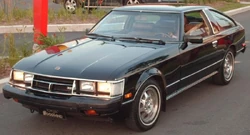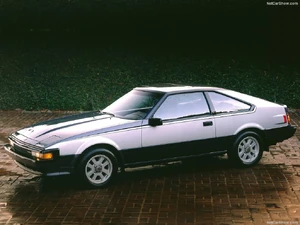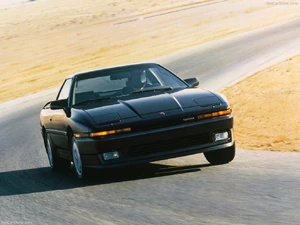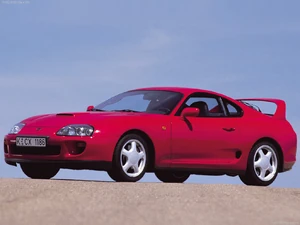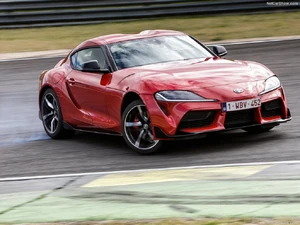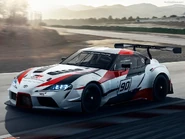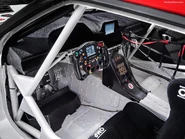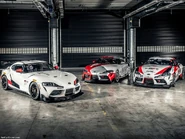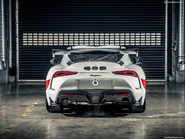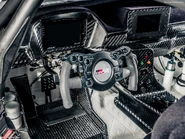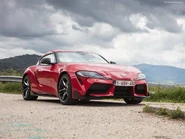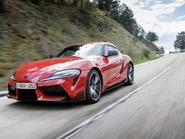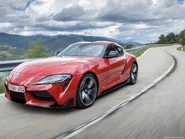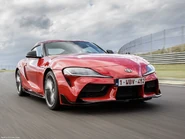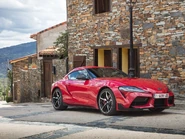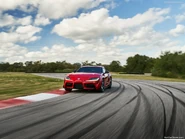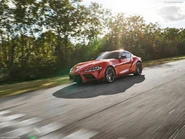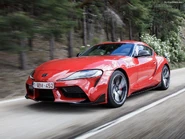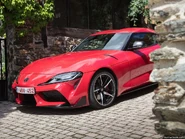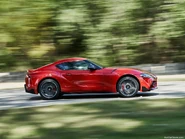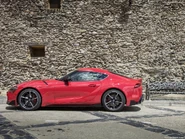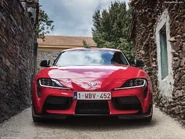No edit summary Tag: Visual edit |
No edit summary Tag: Visual edit |
||
| (19 intermediate revisions by 8 users not shown) | |||
| Line 1: | Line 1: | ||
| + | [[File:Supra-heritage-group-shot-60c954e322bd5f30e41df6906a3f74aa490d0ac1-1607545317.jpg|thumb|460x460px]] |
||
| − | The '''Toyota Celica Supra''' |
+ | The '''Toyota Celica Supra''' is a [[sports car]]/[[grand tourer]] produced by Japanese car manufacturer [[Toyota Motor Company]] from 1979 to the present day. The styling of the Toyota Celica Supra was derived from the [[Toyota Celica]], but it was both longer and wider.<ref name="supfaq">{{cite web|url=http://toyota.custhelp.com/cgi-bin/toyota.cfg/php/enduser/std_adp.php?p_faqid=4077&p_created=990830954&p_sid=bwsHAPpi&p_accessibility=0|title=FAQ: What is the history of the Toyota Supra?|accessdate=2006-12-22|work=toyota.com}}</ref> Starting in mid-1986, the Supra (in its third generation, MKIII) became its own model and was no longer based on the Celica. In turn, Toyota also stopped using the prefix ''Celica'' and began just calling the car ''Supra''.<ref name="OSS">{{cite web|url=http://www.toyota.com/html/shop/vehicles/supra.html|work=Toyota.com|title=Official Toyota Supra Web Site|accessdate=2006-12-22}}</ref> Due to the similarity and past of the [[Toyota Celica]]'s name, it is frequently mistaken for the Toyota Supra, and vice versa. |
The Supra also traces much of its roots back to the [[Toyota 2000GT]] with the main instance being its engine. The first three generations were offered with a direct descendant to the 2000GT's [[Toyota M engine|M engine]]. All four generations of Supra produced have an [[inline-6|inline 6-cylinder engine]], one of the few piston engine configurations with theoretically perfect [[Engine balance|mechanical balance]], leading to very low vibration from the engine. |
The Supra also traces much of its roots back to the [[Toyota 2000GT]] with the main instance being its engine. The first three generations were offered with a direct descendant to the 2000GT's [[Toyota M engine|M engine]]. All four generations of Supra produced have an [[inline-6|inline 6-cylinder engine]], one of the few piston engine configurations with theoretically perfect [[Engine balance|mechanical balance]], leading to very low vibration from the engine. |
||
| Line 68: | Line 69: | ||
|} |
|} |
||
| − | The first generation Supra was based largely upon the Toyota Celica [[liftback]], but was longer by 5.1 in (129.5 mm). The doors and rear section stayed the same length as Celica but rear panels differed. The most important change was the swap to an [[Inline-6]] instead of the stock Celica's [[Straight-4|4-cylinder]] engine. Toyota's original plan for the Supra at this time was to make it a competitor to the very popular [[Datsun]] (now [[Nissan]]) [[Nissan Z-car|Z-car]]. |
+ | The first generation Supra was based largely upon the Toyota Celica [[liftback]], but was longer by 5.1 in (129.5 mm). The doors and rear section stayed the same length as Celica but the rear panels differed. The most important change was the swap to an [[Inline-6]] instead of the stock Celica's [[Straight-4|4-cylinder]] engine. Toyota's original plan for the Supra at this time was to make it a competitor to the very popular [[Datsun]] (now [[Nissan]]) [[Nissan Z-car|Z-car]]. |
===1979=== |
===1979=== |
||
In 1978 Toyota began production of the Mark I Supra in Japan. The year it debuted in the United States and Japan was in 1979. The USA Mark I (chassis code MA46) was originally equipped with a 110 hp (82 kW) 2.6 L (2563 cc) 12-valve [[SOHC]] inline-6 engine ([[Toyota M engine#4M|4M-E]]). Simultaneously in 1979, the Japanese Mark I (chassis code MA45) was offered with a 110 hp (82 kW) 2.0 L 12-valve SOHC inline-6 engine ([[Toyota M engine#M|M-EU]]). Both were the first Toyota engines equipped with [[electronic fuel injection]].<ref name="OSS"/><ref name="EDS">{{cite web|url=http://www4.tpgi.com.au/users/loats/technical/mhistory/mhistory.html|work=eds.au.com|title=The History Of Toyota's M Engines|accessdate=2006-12-22}}</ref> |
In 1978 Toyota began production of the Mark I Supra in Japan. The year it debuted in the United States and Japan was in 1979. The USA Mark I (chassis code MA46) was originally equipped with a 110 hp (82 kW) 2.6 L (2563 cc) 12-valve [[SOHC]] inline-6 engine ([[Toyota M engine#4M|4M-E]]). Simultaneously in 1979, the Japanese Mark I (chassis code MA45) was offered with a 110 hp (82 kW) 2.0 L 12-valve SOHC inline-6 engine ([[Toyota M engine#M|M-EU]]). Both were the first Toyota engines equipped with [[electronic fuel injection]].<ref name="OSS"/><ref name="EDS">{{cite web|url=http://www4.tpgi.com.au/users/loats/technical/mhistory/mhistory.html|work=eds.au.com|title=The History Of Toyota's M Engines|accessdate=2006-12-22}}</ref> |
||
| − | Drivetrain options for the Mark I were either a 5-speed [[manual transmission|manual]] ([[Toyota W transmission#W50|W50]]) or an optional 4-speed [[automatic transmission|automatic]] transmission ([[Toyota A transmission#A40D|A40D]]). Both transmissions featured an overdrive gear. The top gear in the 5-speed was its overdrive gear whereas the automatic transmission featured an overdrive gear that would engage at speeds over 35 mph. The drivetrain for the Supra retained the T series [[solid axle|solid rear axle]] configuration of the Celica in the Japanese MA45 version and a larger F series (and optional [[Limited Slip Differential]]) in the MA46 and MA47. The car also came standard with 4-wheel [[disc brakes]] and featured a [[Multi-link suspension|four-link]] rear suspension with coil springs, lateral [[track bar]], and [[sway bar|stabilizer bar]]. The front suspension consisted of [[MacPherson struts]] and a stabilizer bar. |
+ | Drivetrain options for the Mark I were either a 5-speed [[manual transmission|manual]] ([[Toyota W transmission#W50|W50]]) or an optional 4-speed [[automatic transmission|automatic]] transmission ([[Toyota A transmission#A40D|A40D]]). Both transmissions featured an overdrive gear. The top gear in the 5-speed was its overdrive gear whereas the automatic transmission featured an overdrive gear that would engage at speeds of over 35 mph. The drivetrain for the Supra retained the T series [[solid axle|solid rear axle]] configuration of the Celica in the Japanese MA45 version and a larger F series (and optional [[Limited Slip Differential]]) in the MA46 and MA47. The car also came standard with 4-wheel [[disc brakes]] and featured a [[Multi-link suspension|four-link]] rear suspension with coil springs, lateral [[track bar]], and [[sway bar|stabilizer bar]]. The front suspension consisted of [[MacPherson struts]] and a stabilizer bar. |
On the inside of the Supra one had an option of [[power windows]] and [[power locks]] as part of the convenience package. The convenience package also included [[cruise control]] and special door trim with door pull straps, with an optional [[sunroof]]. As for standard features, in the center console there was an extendable map light and a fliptop armrest, which provided storage. Some other features were the tilt steering wheel, deep zippered pockets on the backs of the front seats, and [[tonneau cover]] under the liftback. The dashboard also contained a state-of-the-art (at the time) AM/FM/MPX 4-speaker stereo radio, analog clock, and tachometer as part of the instrument panel. |
On the inside of the Supra one had an option of [[power windows]] and [[power locks]] as part of the convenience package. The convenience package also included [[cruise control]] and special door trim with door pull straps, with an optional [[sunroof]]. As for standard features, in the center console there was an extendable map light and a fliptop armrest, which provided storage. Some other features were the tilt steering wheel, deep zippered pockets on the backs of the front seats, and [[tonneau cover]] under the liftback. The dashboard also contained a state-of-the-art (at the time) AM/FM/MPX 4-speaker stereo radio, analog clock, and tachometer as part of the instrument panel. |
||
| Line 87: | Line 88: | ||
In the coming year, 1981, the Supra received an upgrade in displacement with the 2.8 L (2759 cc) [[Toyota M engine#5M|5M-E]] engine. It is still a 12-valve SOHC engine, but makes 116 hp (87 kW) and 145 ft·lbf (197 N·m) of torque. The cars automatic transmission was changed to the revised Toyota [[Toyota A transmission#A43D|A43D]] and it gained a revised final drive gearing. Because of the change in engine and transmission they dubbed a new chassis code of MA47. The final year of the MK I Supra it achieved a 0-60 MPH time of 10.24 seconds and finished the 1/4 mile in 17.5 seconds at 77.7 MPH.<ref name="mtsvs"/> |
In the coming year, 1981, the Supra received an upgrade in displacement with the 2.8 L (2759 cc) [[Toyota M engine#5M|5M-E]] engine. It is still a 12-valve SOHC engine, but makes 116 hp (87 kW) and 145 ft·lbf (197 N·m) of torque. The cars automatic transmission was changed to the revised Toyota [[Toyota A transmission#A43D|A43D]] and it gained a revised final drive gearing. Because of the change in engine and transmission they dubbed a new chassis code of MA47. The final year of the MK I Supra it achieved a 0-60 MPH time of 10.24 seconds and finished the 1/4 mile in 17.5 seconds at 77.7 MPH.<ref name="mtsvs"/> |
||
| − | Also in 1981, a new Sports Performance Package became an option, which included sport suspension, raised white letter tires, and front and rear spoilers. This also marked the last year that the 8-track cartridge was offered |
+ | Also in 1981, a new Sports Performance Package became an option, which included sport suspension, raised white letter tires, and front and rear spoilers. This also marked the last year that the 8-track cartridge was offered on any Supra.<ref name="OSS"/><ref name="csMKI"/> |
<!-- START MKI QUICK INFO TABLE --> |
<!-- START MKI QUICK INFO TABLE --> |
||
| Line 145: | Line 146: | ||
{| border=0 cellspacing=0 cellpadding=4 style="float:right; margin:0 0 .5em 1em; width:250px; background:#fff; border-collapse:collapse; border:1px solid #999; font-size:83%; line-height:1.5; " summary="Infobox Automobile" |
{| border=0 cellspacing=0 cellpadding=4 style="float:right; margin:0 0 .5em 1em; width:250px; background:#fff; border-collapse:collapse; border:1px solid #999; font-size:83%; line-height:1.5; " summary="Infobox Automobile" |
||
|- style="text-align:center; background:#f0f0f0;" |
|- style="text-align:center; background:#f0f0f0;" |
||
| − | | colspan=2 style="padding:0; background:#996; color:#fff; border-bottom:1px solid #999;" | |
+ | | colspan=2 style="padding:0; background:#996; color:#fff; border-bottom:1px solid #999;" |[[File:Toyota-Supra-1985-1024-01.jpg|center|thumb|300x300px]] |
| − | [[File:800px-2nd-Toyota-Supra.jpg|250px]] |
||
|- style="color:#fff; background:#996; font-size:larger;" |
|- style="color:#fff; background:#996; font-size:larger;" |
||
! colspan=2 | '''Toyota Celica Supra MK II''' |
! colspan=2 | '''Toyota Celica Supra MK II''' |
||
| Line 207: | Line 207: | ||
===L-type and P-type=== |
===L-type and P-type=== |
||
| − | In the North American market, the Celica Supra was available in two distinct models to accommodate any persons tastes. There was of course the Performance Type (P-type henceforth) and the Luxury Type (L-type henceforth). While being mechanically identical, they were differentiated by the available options; tire sizes, wheel sizes, and body trim. The P-type had [[fiberglass]] fender flares over the wheel wells, while the L-type did not. The P-type was also standard with the more sporty 8-way adjustable seats. The P-type did not get the option of a leather interior until 1983. All editions of the P-Type had the same 14x7 aluminum alloy rims and throughout the years the L-Type had 14"x5.5" rims until 1985 when they were changed to a P-type style 15x6. The L-type also had the option of a digital dash with [[trip computer]], whereas the P-Type was only offered with an analog dash (with digital clock). The digital dash featured a digital tachometer, digital speedometer, and electronic fuel level and coolant level gauges. The trip computer could calculate and display various things such as [[fuel economy]] in miles-per-gallon, estimated time of arrival (ETA), and distance remaining to destination. Excluding the 1982 model, all P-types were available with headlight washers as an option, but the L-types were never fitted with such an option. Although gear ratios changed throughout the years all P-types came as standard with a [[limited slip differential]]. |
+ | In the North American market, the Celica Supra was available in two distinct models to accommodate any persons tastes. There was of course the Performance Type (P-type henceforth) and the Luxury Type (L-type henceforth). While being mechanically identical, they were differentiated by the available options; tire sizes, wheel sizes, and body trim. The P-type had [[fiberglass]] fender flares over the wheel wells, while the L-type did not. The P-type was also standard with the more sporty 8-way adjustable seats. The P-type did not get the option of a leather interior until 1983. All editions of the P-Type had the same 14x7 aluminum alloy rims and throughout the years the L-Type had 14"x5.5" rims until 1985 when they were changed to a P-type style 15x6. The L-type also had the option of a digital dash with [[trip computer]], whereas the P-Type was only offered with an analog dash (with digital clock). The digital dash featured a digital tachometer, digital speedometer, and electronic fuel level and coolant level gauges. The trip computer could calculate and display various things such as [[fuel economy]] in miles-per-gallon, estimated time of arrival (ETA), and distance remaining to the chosen destination. Excluding the 1982 model, all P-types were available with headlight washers as an option, but the L-types were never fitted with such an option. Although gear ratios changed throughout the years all P-types came as standard with a [[limited slip differential]]. |
===1982=== |
===1982=== |
||
| Line 371: | Line 371: | ||
{| border=0 cellspacing=0 cellpadding=4 style="float:right; margin:0 0 .5em 1em; width:250px; background:#fff; border-collapse:collapse; border:1px solid #999; font-size:83%; line-height:1.5; " summary="Infobox Automobile" |
{| border=0 cellspacing=0 cellpadding=4 style="float:right; margin:0 0 .5em 1em; width:250px; background:#fff; border-collapse:collapse; border:1px solid #999; font-size:83%; line-height:1.5; " summary="Infobox Automobile" |
||
|- style="text-align:center; background:#f0f0f0;" |
|- style="text-align:center; background:#f0f0f0;" |
||
| − | | colspan=2 style="padding:0; background:#996; color:#fff; border-bottom:1px solid #999;" | |
+ | | colspan=2 style="padding:0; background:#996; color:#fff; border-bottom:1px solid #999;" |[[File:Toyota-Supra-1987-1024-03.jpg|center|thumb|300x300px]] |
| − | [[File:===.jpg|250px]] |
||
|- style="color:#fff; background:#996; font-size:larger;" |
|- style="color:#fff; background:#996; font-size:larger;" |
||
! colspan=2 | '''Toyota Supra MK III''' |
! colspan=2 | '''Toyota Supra MK III''' |
||
| Line 510: | Line 509: | ||
{| border=0 cellspacing=0 cellpadding=4 style="float:right; margin:0 0 .5em 1em; width:250px; background:#fff; border-collapse:collapse; border:1px solid #999; font-size:83%; line-height:1.5; " summary="Infobox Automobile" |
{| border=0 cellspacing=0 cellpadding=4 style="float:right; margin:0 0 .5em 1em; width:250px; background:#fff; border-collapse:collapse; border:1px solid #999; font-size:83%; line-height:1.5; " summary="Infobox Automobile" |
||
|- style="text-align:center; background:#f0f0f0;" |
|- style="text-align:center; background:#f0f0f0;" |
||
| − | | colspan=2 style="padding:0; background:#996; color:#fff; border-bottom:1px solid #999;" | |
+ | | colspan=2 style="padding:0; background:#996; color:#fff; border-bottom:1px solid #999;" |[[File:Toyota-Supra-1996-1024-05.jpg|center|thumb|300x300px]] |
| − | [[File:800px-'93-'95_Toyota_Supra.jpg|250px]] |
||
|- style="color:#fff; background:#996; font-size:larger;" |
|- style="color:#fff; background:#996; font-size:larger;" |
||
! colspan=2 | '''Toyota Supra MK IV''' |
! colspan=2 | '''Toyota Supra MK IV''' |
||
| Line 595: | Line 593: | ||
{| border=0 cellspacing=0 cellpadding=4 style="float:right; margin:0 0 .5em 1em; width:250px; background:#fff; border-collapse:collapse; border:1px solid #999; font-size:83%; line-height:1.5; " summary="Infobox Automobile" |
{| border=0 cellspacing=0 cellpadding=4 style="float:right; margin:0 0 .5em 1em; width:250px; background:#fff; border-collapse:collapse; border:1px solid #999; font-size:83%; line-height:1.5; " summary="Infobox Automobile" |
||
|- style="text-align:center; background:#f0f0f0;" |
|- style="text-align:center; background:#f0f0f0;" |
||
| − | | colspan=2 style="padding:0; background:#996; color:#fff; border-bottom:1px solid #999;" | |
+ | | colspan=2 style="padding:0; background:#996; color:#fff; border-bottom:1px solid #999;" |[[File:Toyota-Supra-2020-1024-17.jpg|center|frameless|300x300px]] |
|- style="color:#fff; background:#996; font-size:larger;" |
|- style="color:#fff; background:#996; font-size:larger;" |
||
! colspan=2 | '''Toyota Supra MK V''' |
! colspan=2 | '''Toyota Supra MK V''' |
||
| Line 604: | Line 602: | ||
| Mk. V |
| Mk. V |
||
|- style="vertical-align:top; background:#f0f0f0;" |
|- style="vertical-align:top; background:#f0f0f0;" |
||
| − | | Production |
+ | | Production |
|2020- |
|2020- |
||
|- style="vertical-align:top;" |
|- style="vertical-align:top;" |
||
| Class |
| Class |
||
| + | |Sports |
||
| − | | |
||
|- style="vertical-align:top; background:#f0f0f0;" |
|- style="vertical-align:top; background:#f0f0f0;" |
||
| Body Style |
| Body Style |
||
| Line 647: | Line 645: | ||
Throughout the past couple of years, major print and online auto publications have hinted at a possible revival of the Supra in 2007/2008, pointing the car in different directions. The vehicle was originally thought to be the flagship or halo model in the Toyota lineup, be powered by a high output V8, and have an estimated cost anywhere between $50,000 and $70,000. Other rumors hint at a V10 F1-inspired powerplant, like the current [[BMW M5]] and [[BMW M6|M6]], though current F1 engines have been downgraded to V8s. Power is likely 450 bhp or more, as this was likely due to the increasing number of sighting of a high performance sports car being tested throughout Europe and, more specifically, on the [[Nürburgring]]. These vehicles turned out to be the test mules for Lexus' future [[Lexus LF-A]].<ref name="LFA">{{cite web|url=http://www.lexus.ca/lexus/experience/en/home/concept/concept_vehicles.jsp|work=lexus.ca|title=Lexus LF-A|accessdate=2006-12-22}}</ref> |
Throughout the past couple of years, major print and online auto publications have hinted at a possible revival of the Supra in 2007/2008, pointing the car in different directions. The vehicle was originally thought to be the flagship or halo model in the Toyota lineup, be powered by a high output V8, and have an estimated cost anywhere between $50,000 and $70,000. Other rumors hint at a V10 F1-inspired powerplant, like the current [[BMW M5]] and [[BMW M6|M6]], though current F1 engines have been downgraded to V8s. Power is likely 450 bhp or more, as this was likely due to the increasing number of sighting of a high performance sports car being tested throughout Europe and, more specifically, on the [[Nürburgring]]. These vehicles turned out to be the test mules for Lexus' future [[Lexus LF-A]].<ref name="LFA">{{cite web|url=http://www.lexus.ca/lexus/experience/en/home/concept/concept_vehicles.jsp|work=lexus.ca|title=Lexus LF-A|accessdate=2006-12-22}}</ref> |
||
| − | After this was discovered, it was then believed that that if a new Supra were to be released, it will be positioned to compete directly against the [[Nissan Skyline]]. It was expected to be available as a coupe and convertible, have a V6 producing around 350+ hp, and cost between $25,000 and $35,000. Throughout recent years, different publications as well as fans of the Supra have created several |
+ | After this was discovered, it was then believed that that if a new Supra were to be released, it will be positioned to compete directly against the [[Nissan Skyline]]. It was expected to be available as a coupe and convertible, have a V6 producing around 350+ hp, and cost between $25,000 and $35,000. Throughout recent years, different publications as well as fans of the Supra have created several renditions of what a new Supra might look like if it were ever to be produced. |
Topspeed.com was among a number of publications that claimed that there will be a return of the Supra in 2008 <ref name="topspeed.com">{{cite web|url=http://www.topspeed.com/cars/toyota/toyota-supra-ar6872.html|work=topspeed.com|title=2008 Toyota Supra|accessdate=2006-12-22}}</ref> but Toyota disclaimed this rumor on August 15, 2006. The same numerous publications that originally speculated on a future Supra all stated no new vehicle was being developed. According to an ''AutoWeek'' article on current and upcoming Toyota vehicles, all rumors on the Supra's return are false.<ref name="AutoWeekNoSupra">{{cite web|url=http://www.autoweek.com/apps/pbcs.dll/article?AID=/20060815/FREE/60814015/1041/TOC01ARCHIVE|title=Future Products--Toyota|accessdate=2006-12-22|date=2006-08-15|publisher=[[AutoWeek]]}}</ref> ''Automotive News'' also claim Toyota has absolutely no plans for a Supra in the future.<ref name="LeftLaneNoSupra">[http://www.leftlanenews.com/2006/08/15/report-no-new-supra-is-convertible-delayed-new-sc-in-2008/ Report: No New Supra] - Left Lane News article stating no future Supra is currently being planned</ref> |
Topspeed.com was among a number of publications that claimed that there will be a return of the Supra in 2008 <ref name="topspeed.com">{{cite web|url=http://www.topspeed.com/cars/toyota/toyota-supra-ar6872.html|work=topspeed.com|title=2008 Toyota Supra|accessdate=2006-12-22}}</ref> but Toyota disclaimed this rumor on August 15, 2006. The same numerous publications that originally speculated on a future Supra all stated no new vehicle was being developed. According to an ''AutoWeek'' article on current and upcoming Toyota vehicles, all rumors on the Supra's return are false.<ref name="AutoWeekNoSupra">{{cite web|url=http://www.autoweek.com/apps/pbcs.dll/article?AID=/20060815/FREE/60814015/1041/TOC01ARCHIVE|title=Future Products--Toyota|accessdate=2006-12-22|date=2006-08-15|publisher=[[AutoWeek]]}}</ref> ''Automotive News'' also claim Toyota has absolutely no plans for a Supra in the future.<ref name="LeftLaneNoSupra">[http://www.leftlanenews.com/2006/08/15/report-no-new-supra-is-convertible-delayed-new-sc-in-2008/ Report: No New Supra] - Left Lane News article stating no future Supra is currently being planned</ref> |
||
| Line 671: | Line 669: | ||
=== Launch === |
=== Launch === |
||
The fifth generation of the Supra made its debut at the January [[North American International Auto Show#2019|2019 North American International Auto Show]] as a 2020 model.<ref>{{cite press release |url=https://newsroom.toyota.co.jp/en/toyota/26144480.html |title=Toyota Premieres New Supra at Detroit Auto Show |publisher=Toyota |location=Japan |date=14 January 2019 |access-date=16 January 2019}}</ref><ref>{{cite news |url=https://www.motor1.com/news/300869/2020-toyota-supra-horsepower-details/ |title=2020 Toyota Supra Debuts With 335 HP After A Decade Of Foreplay |first=Jeff |last=Perez |work=Motor 1 |location=US |date=14 January 2019 |access-date=16 January 2019}}</ref><ref>{{cite news |url=https://paultan.org/2019/01/15/toyota-gr-supra-revealed-first-global-gazoo-racing-model-340-ps-3-0l-straight-six-priced-from-rm205k/ |title=Toyota GR Supra revealed – first global Gazoo Racing model, 340 PS 3.0L straight-six priced from RM205k |first=Jonathan |last=Lee |work=paultan.org |location=Malaysia |date=15 January 2019 |access-date=16 January 2019}}</ref><ref>{{cite news |url=https://www.carscoops.com/2019/01/2020-toyota-supra-launch-edition-exclusive-1500-u-s-buyers-costs-55250/ |title=2020 Toyota Supra Launch Edition Is Exclusive To 1500 U.S. Buyers, Costs $55,250 |first=Brad |last=Anderson |work=Carscoops |location=US |date=14 January 2019 |access-date=16 January 2019}}</ref><ref>{{cite news |url=https://www.caranddriver.com/news/a24443721/2020-toyota-supra-photos-info/ |title=The 2020 Toyota Supra Is a Resurrection of a Hero |first=John Pearley |last=Huffman |work=Car and Driver |location=US |date=14 January 2019 |access-date=16 January 2019}}</ref><ref>{{cite news |url=https://www.caradvice.com.au/716395/2020-toyota-supra-unveiled/ |title=2020 Toyota Supra Unveiled: Japan's Latest Hero Goes Official at Last |first=Mike |last=Stevens |work=CarAdvice |location=Australia |date=14 January 2019 |access-date=16 January 2019}}</ref><ref>{{cite news |url=https://www.motortrend.com/cars/toyota/supra/2020/2020-toyota-supra-first-look-review/ |title=Supra Returns! The Inside Story on the 2020 Toyota Supra's Comeback |first=Chris |last=Walton |work=Motor Trend |location=US |date=14 January 2019 |access-date=16 January 2019}}</ref><ref>{{Cite web|url=https://www.caranddriver.com/news/a19123752/toyota-gr-supra-racing-concept-the-supra-is-officially-back-news|title=Toyota GR Supra Racing Concept: The Supra Is Officially Back!|last=Johnson|first=Erik|date=6 March 2018|website=Car and Driver|language=en-US|access-date=27 January 2019}}</ref> The first production model was auctioned at a price of $2.1 million at [[Barrett-Jackson]] auction in January 2019, with 100% of the money going to the [[American Heart Association]] and the Bob Woodruff Foundation.<ref>{{Cite news |url=https://www.motor1.com/news/301709/first-2020-toyota-supra-auction/ |title=First Production 2020 Toyota Supra Sold For $2.1M At Auction |first=Jacob |last=Oliva |work=Motor1 |location=US |date=19 January 2019 |access-date=21 January 2019}}</ref><ref>{{Cite news |url=https://www.carwow.co.uk/toyota/news/2723/toyota-supra-price-specs-release-date |title=2020 Toyota Supra price, specs and release date |first=Matthew |last=Mills |work=carwow |location=UK |date=15 January 2019 |access-date=21 January 2019}}</ref> The auction car has a one-off matte grey exterior color which is not offered on the standard Supra, as well as a red interior, metallic black 5-bolt wheels, red wing mirrors, a signature from Toyota CEO [[Akio Toyoda]] on the dashboard and [[VIN]] number 20201.<ref>{{Cite web|url=https://www.motortrend.com/news/first-2020-toyota-supra-auction-barrett-jackson/#2s6a1680|title=FIRST 2020 TOYOTA SUPRA SOLD FOR $2.1 MILLION AT BARRETT-JACKSON AUCTION|last=|first=|date=|website=|archive-url=|archive-date=|dead-url=|access-date=}}</ref> Sales for the production car will begin sometime around the first quarter of 2019 with an expected price tag of $50,920 in the United States.<ref>{{Cite news |url=https://www.motor1.com/news/300919/2020-toyota-supra-pricing-us/ |title=2020 Toyota Supra Pricing Starts At $49,990 In U.S. |first=Christoper |last=Smith |work=Motor1 |location=US |date=14 January 2019 |access-date=21 January 2019}}</ref> |
The fifth generation of the Supra made its debut at the January [[North American International Auto Show#2019|2019 North American International Auto Show]] as a 2020 model.<ref>{{cite press release |url=https://newsroom.toyota.co.jp/en/toyota/26144480.html |title=Toyota Premieres New Supra at Detroit Auto Show |publisher=Toyota |location=Japan |date=14 January 2019 |access-date=16 January 2019}}</ref><ref>{{cite news |url=https://www.motor1.com/news/300869/2020-toyota-supra-horsepower-details/ |title=2020 Toyota Supra Debuts With 335 HP After A Decade Of Foreplay |first=Jeff |last=Perez |work=Motor 1 |location=US |date=14 January 2019 |access-date=16 January 2019}}</ref><ref>{{cite news |url=https://paultan.org/2019/01/15/toyota-gr-supra-revealed-first-global-gazoo-racing-model-340-ps-3-0l-straight-six-priced-from-rm205k/ |title=Toyota GR Supra revealed – first global Gazoo Racing model, 340 PS 3.0L straight-six priced from RM205k |first=Jonathan |last=Lee |work=paultan.org |location=Malaysia |date=15 January 2019 |access-date=16 January 2019}}</ref><ref>{{cite news |url=https://www.carscoops.com/2019/01/2020-toyota-supra-launch-edition-exclusive-1500-u-s-buyers-costs-55250/ |title=2020 Toyota Supra Launch Edition Is Exclusive To 1500 U.S. Buyers, Costs $55,250 |first=Brad |last=Anderson |work=Carscoops |location=US |date=14 January 2019 |access-date=16 January 2019}}</ref><ref>{{cite news |url=https://www.caranddriver.com/news/a24443721/2020-toyota-supra-photos-info/ |title=The 2020 Toyota Supra Is a Resurrection of a Hero |first=John Pearley |last=Huffman |work=Car and Driver |location=US |date=14 January 2019 |access-date=16 January 2019}}</ref><ref>{{cite news |url=https://www.caradvice.com.au/716395/2020-toyota-supra-unveiled/ |title=2020 Toyota Supra Unveiled: Japan's Latest Hero Goes Official at Last |first=Mike |last=Stevens |work=CarAdvice |location=Australia |date=14 January 2019 |access-date=16 January 2019}}</ref><ref>{{cite news |url=https://www.motortrend.com/cars/toyota/supra/2020/2020-toyota-supra-first-look-review/ |title=Supra Returns! The Inside Story on the 2020 Toyota Supra's Comeback |first=Chris |last=Walton |work=Motor Trend |location=US |date=14 January 2019 |access-date=16 January 2019}}</ref><ref>{{Cite web|url=https://www.caranddriver.com/news/a19123752/toyota-gr-supra-racing-concept-the-supra-is-officially-back-news|title=Toyota GR Supra Racing Concept: The Supra Is Officially Back!|last=Johnson|first=Erik|date=6 March 2018|website=Car and Driver|language=en-US|access-date=27 January 2019}}</ref> The first production model was auctioned at a price of $2.1 million at [[Barrett-Jackson]] auction in January 2019, with 100% of the money going to the [[American Heart Association]] and the Bob Woodruff Foundation.<ref>{{Cite news |url=https://www.motor1.com/news/301709/first-2020-toyota-supra-auction/ |title=First Production 2020 Toyota Supra Sold For $2.1M At Auction |first=Jacob |last=Oliva |work=Motor1 |location=US |date=19 January 2019 |access-date=21 January 2019}}</ref><ref>{{Cite news |url=https://www.carwow.co.uk/toyota/news/2723/toyota-supra-price-specs-release-date |title=2020 Toyota Supra price, specs and release date |first=Matthew |last=Mills |work=carwow |location=UK |date=15 January 2019 |access-date=21 January 2019}}</ref> The auction car has a one-off matte grey exterior color which is not offered on the standard Supra, as well as a red interior, metallic black 5-bolt wheels, red wing mirrors, a signature from Toyota CEO [[Akio Toyoda]] on the dashboard and [[VIN]] number 20201.<ref>{{Cite web|url=https://www.motortrend.com/news/first-2020-toyota-supra-auction-barrett-jackson/#2s6a1680|title=FIRST 2020 TOYOTA SUPRA SOLD FOR $2.1 MILLION AT BARRETT-JACKSON AUCTION|last=|first=|date=|website=|archive-url=|archive-date=|dead-url=|access-date=}}</ref> Sales for the production car will begin sometime around the first quarter of 2019 with an expected price tag of $50,920 in the United States.<ref>{{Cite news |url=https://www.motor1.com/news/300919/2020-toyota-supra-pricing-us/ |title=2020 Toyota Supra Pricing Starts At $49,990 In U.S. |first=Christoper |last=Smith |work=Motor1 |location=US |date=14 January 2019 |access-date=21 January 2019}}</ref> |
||
| + | |||
| + | The Supra went on sale in Japan on 17 May 2019. In the United States, sales began on 22 July 2019 with a starting base price tag of US$49,990. In Australia, sales began on 2 September 2019. |
||
=== Engine === |
=== Engine === |
||
| − | The Supra is powered by two [[BMW]]-sourced engine options: a turbocharged 2.0-liter inline-four or a turbocharged 3.0-litre inline-six engine. The 2.0-litre engine is currently not offered for the US market, leaving the 3.0-liter inline-six as the only engine option available. The 2.0-litre engine has a power output of 145–190 kW (194–255 hp; 197–258 PS) from 1,600 to 4,500 rpm, with power sent to the rear wheels through a [[ZF Friedrichshafen|ZF]] ''[[ZF 8HP|8HP]]'' 8-speed automatic transmission.<ref>{{Cite web|url=https://jalopnik.com/the-2020-toyota-supra-is-finally-here-with-335-hp-does-1831719119|title=The 2020 Toyota Supra Is Finally Here With 335 HP, Does Zero to 60 in 4.1 Seconds|last=George|first=Patrick|website=Jalopnik|language=en-US|access-date=31 January 2019}}</ref> A manual transmission option is currently not offered. The 2.0 L model can accelerate from 0–97 km/h (0–60 mph) in 5.2 to 6.5 seconds, while the 3.0 L model can accelerate from 0–97 km/h (0–60 mph) in 4.1 seconds, 1.1 seconds quicker than the turbocharged variant of the ''A80'' Supra and has an electronically limited top speed of 249 km/h or 155 mph.<ref>{{Cite web|url=https://www.roadandtrack.com/new-cars/future-cars/a12635049/2019-toyota-supra-what-we-know/|title=2020 Toyota Supra: Everything We Know|last=Perkins|first=Chris|date=23 January 2019|website=Road & Track|language=en-US|access-date=31 January 2019}}</ref> |
+ | The Supra is powered by two [[BMW]]-sourced engine options: a turbocharged 2.0-liter inline-four or a turbocharged 3.0-litre inline-six engine. The 2.0-litre engine is currently not offered for the US market, leaving the 3.0-liter inline-six as the only engine option available. The 2.0-litre engine has a power output of 145–190 kW (194–255 hp; 197–258 PS) from 1,600 to 4,500 rpm, with power sent to the rear wheels through a [[ZF Friedrichshafen|ZF]] ''[[ZF 8HP|8HP]]'' 8-speed automatic transmission.<ref>{{Cite web|url=https://jalopnik.com/the-2020-toyota-supra-is-finally-here-with-335-hp-does-1831719119|title=The 2020 Toyota Supra Is Finally Here With 335 HP, Does Zero to 60 in 4.1 Seconds|last=George|first=Patrick|website=Jalopnik|language=en-US|access-date=31 January 2019}}</ref> A manual transmission option is currently not offered. The 2.0 L model can accelerate from 0–97 km/h (0–60 mph) in 5.2 to 6.5 seconds, while the 3.0 L model can accelerate from 0–97 km/h (0–60 mph) in 4.1 seconds, 1.1 seconds quicker than the turbocharged variant of the ''A80'' Supra and has an electronically limited top speed of 249 km/h or 155 mph.<ref>{{Cite web|url=https://www.roadandtrack.com/new-cars/future-cars/a12635049/2019-toyota-supra-what-we-know/|title=2020 Toyota Supra: Everything We Know|last=Perkins|first=Chris|date=23 January 2019|website=Road & Track|language=en-US|access-date=31 January 2019}}</ref> Toyota initially considered to give the new Supra a dual-clutch automatic transmission, but went with the ZF 8HP for its smoothness, reliability, and weight savings. A manual transmission was initially not offered, due to its torque-converter automatic having quick shifts, its ability to handle a lot of torque with self-awareness on its aftermarket potential, and wanting to differentiate it from the 86. A 6-speed manual transmission option will be available in 2022 for the 2023 model year for the six-cylinder engine only. The transmission is a modified ZF unit, and receives a shorter final drive ratio compared to the automatic as well as a rev-matching function. |
| + | |||
| + | Before production, Toyota wanted to build a front-engine rear-wheel drive turbocharged inline-six pure sports car that would compete against the Porsche Cayman and be a track and street weapon, all while avoiding supercar prices, while BMW wanted to build a roadster, which gave them the idea of co-developing an all-new platform that would handle both coupe and convertible variants with great rigidity and handling of torque. The platform takes few elements from BMW's M cars that were praised by both Toyota and BMW for their characteristics, such as the suspension design, forged control arms and electronic differential, all while being able to reduce costs for production and the final product. After co-developing the platform together, Toyota and BMW went to develop the rest of the two cars separately, such as chassis development, exterior and interior designs, and tuning of both drivetrain and suspension. |
||
=== Markets === |
=== Markets === |
||
| Line 680: | Line 682: | ||
The first 1,500 cars sold are the special ''Launch Edition'' models, which are based on the ''3.0 Premium'' model and offered in three exterior colour options: ''Absolute Zero White'', ''Nocturnal Black'' and ''Renaissance Red 2.0''.<ref>{{Cite web|url=https://www.caranddriver.com/news/a25868570/2020-toyota-supra-launch-edition/|title=First 1500 Toyota Supra Buyers Get This Special Launch Edition|last=Capparella|first=Joey|date=20 January 2019|website=Car and Driver|language=en-US|access-date=31 January 2019}}</ref> Cars that have the white or black exterior colour have the same red interior as the auction car, which is only offered in the ''Launch Edition'' models, while the red cars have a black interior. All ''Launch Edition'' cars have a red coloured wing mirrors and a replica of Akio Toyoda's signature on a carbon fiber plaque fixed to the dashboard, mirroring the auction car.<ref>{{Cite web|url=https://www.motortrend.com/news/2020-toyota-supra-priced-starting-at-50920/#2020-toyota-supra-launch-edition-rear-three-quarter|title=2020 TOYOTA SUPRA PRICED STARTING AT $50,920|last=|first=|date=|website=|archive-url=|archive-date=|dead-url=|access-date=}}</ref> |
The first 1,500 cars sold are the special ''Launch Edition'' models, which are based on the ''3.0 Premium'' model and offered in three exterior colour options: ''Absolute Zero White'', ''Nocturnal Black'' and ''Renaissance Red 2.0''.<ref>{{Cite web|url=https://www.caranddriver.com/news/a25868570/2020-toyota-supra-launch-edition/|title=First 1500 Toyota Supra Buyers Get This Special Launch Edition|last=Capparella|first=Joey|date=20 January 2019|website=Car and Driver|language=en-US|access-date=31 January 2019}}</ref> Cars that have the white or black exterior colour have the same red interior as the auction car, which is only offered in the ''Launch Edition'' models, while the red cars have a black interior. All ''Launch Edition'' cars have a red coloured wing mirrors and a replica of Akio Toyoda's signature on a carbon fiber plaque fixed to the dashboard, mirroring the auction car.<ref>{{Cite web|url=https://www.motortrend.com/news/2020-toyota-supra-priced-starting-at-50920/#2020-toyota-supra-launch-edition-rear-three-quarter|title=2020 TOYOTA SUPRA PRICED STARTING AT $50,920|last=|first=|date=|website=|archive-url=|archive-date=|dead-url=|access-date=}}</ref> |
||
| + | |||
| + | For the 2021 model year, two new models, the A91 Edition and the 2.0, will be introduced. For the 3.0, 3.0 Premium, and A91 Edition, the output of the 3-litre engine will be increased to 285 kW (382 hp) and 499 N⋅m (368 lb⋅ft) of torque. The 2.0 will feature the same 2-litre engine used in the SZ and SZ-R models sold in Japan, and is rated at 190 kW (255 hp) and 400 N⋅m (295 lb⋅ft) of torque. |
||
| + | |||
| + | In 2022, for the 2023 model year, the Supra 3.0 and 3.0 Premium will be available with a 6-speed manual transmission, with a limited A91-MT Edition also available. |
||
| + | |||
| + | ==== Japan ==== |
||
| + | The Supra is offered in three trim levels, which are the SZ, SZ-R and RZ. The SZ model is powered by the 145 kW (194 hp; 197 PS) 2.0-litre engine and is equipped with 17-inch single tone wheels, manual seats, black fabric upholstery, dark silver trim and a 4-speaker sound system. The SZ-R model is powered by the 190 kW (255 hp; 258 PS) variation of the 2.0-litre engine and is equipped with 18-inch two tone wheels, eight-way powered seats, Alcantara/black leather upholstery, carbon fibre trim, 8.8-inch touchscreen multimedia system with 12-speaker JBL stereo sound system and a head-up display. The RZ model is powered by the 3.0-litre engine and is equipped with 19-inch two tone wheels. It also has the same interior equipments as the SZ-R model, with the difference being the use of Alcantara/red leather upholstery (black leather is available as an option) and sports pedals. A "Sport" mode and dual-zone climate control system is standard on all three variants, as is the Toyota Supra Connect infotainment system. All variants are also equipped with Toyota Supra Safety suite, which includes autonomous emergency braking, lane departure alert, blind spot monitor, adaptive cruise control and rear-cross traffic alert. GR Parts is also available, including the Toyota Gazoo Racing Recorder, which allows drivers to log their driving data to an SD card. This can be supplemented by an optional dashcam, which synchronises the video with the recorded information. |
||
| + | |||
| + | === Motorsport === |
||
| + | |||
| + | ==== GR Supra Racing Concept ==== |
||
| + | The GR Supra Racing Concept is a concept racing car that previews the racing version of the fifth generation Supra. It debuted at the March 2018 [[Geneva Motor Show]]. The design was inspired from the 2014 FT-1 concept. It features a lowered suspension with Toyota OEM parts, BBS center-lock racing wheels, Brembo racing calipers, a full roll cage and fire extinguisher system, a stripped out interior, Michelin track tires and a center exit racing exhaust. It also features carbon fibre for the hood, splitter, diffuser, mirror caps, side skirts, wing and bumpers. It is unknown what engine powered the concept.<gallery> |
||
| + | File:Toyota-GR Supra Racing Concept-2018-1024-02.jpg |
||
| + | File:Toyota-GR Supra Racing Concept-2018-1024-03.jpg |
||
| + | File:Toyota-GR Supra Racing Concept-2018-1024-04.jpg |
||
| + | File:Toyota-GR Supra Racing Concept-2018-1024-05.jpg |
||
| + | File:Toyota-GR Supra Racing Concept-2018-1024-10.jpg |
||
| ⚫ | |||
| + | |||
| + | ==== GR Supra GT4 ==== |
||
| + | The GR Supra GT4 Concept is a concept racing car that is built for participating in the European GT4 racing series. It was first shown at the March 2019 Geneva Motor Show. Upgrades include reduced weight, upgraded brakes and suspension and the addition of a rear wing and roll cage. |
||
| + | |||
| + | Toyota later unveiled a production model in October 2019, with an engine rated at 320 kW (429 hp; 435 PS). It has a seven-speed automatic, as opposed to the eight-speed unit on standard road going models, and has an Akrapovič exhaust system which enables the increase in power. Inside, an FIA-standard racing seat is present featuring a six-point harness, along with a carbon fibre instrument cluster. Motorsport ABS, a data logger and a fire extinguisher are standard, while an illuminated car number is optional. The GT4 is equipped with six-piston front and four-piston rear brake calipers. Pirelli P Zero racing tires and OZ wheels are fitted, supported by KW dampers. The roll cage and rear wing are also carried over from the concept. Sales began in Europe in March 2020, followed by North America in August 2020 and Japan/Southeast Asia in October 2020.<gallery> |
||
| + | File:Toyota-Supra GT4-2020-1024-0f.jpg |
||
| + | File:Toyota-Supra GT4-2020-1024-0a.jpg |
||
| + | File:Toyota-Supra GT4-2020-1024-0b.jpg |
||
| + | File:Toyota-Supra GT4-2020-1024-0c.jpg |
||
| + | File:Toyota-Supra GT4-2020-1024-0d.jpg |
||
| + | File:Toyota-Supra GT4-2020-1024-0e.jpg |
||
| + | File:Toyota-Supra GT4-2020-1024-10.jpg |
||
| + | </gallery> |
||
==Gallery== |
==Gallery== |
||
<gallery> |
<gallery> |
||
| + | File:Toyota-Supra-2020-1024-01.jpg |
||
| ⚫ | |||
| + | File:Toyota-Supra-2020-1024-20.jpg |
||
| + | File:Toyota-Supra-2020-1024-1f.jpg |
||
| + | File:Toyota-Supra-2020-1024-1a.jpg |
||
| + | File:Toyota-Supra-2020-1024-18.jpg |
||
| + | File:Toyota-Supra-2020-1024-19.jpg |
||
| + | File:Toyota-Supra-2020-1024-02.jpg |
||
| + | File:Toyota-Supra-2020-1024-28.jpg |
||
| + | File:Toyota-Supra-2020-1024-29.jpg |
||
| + | File:Toyota-Supra-2020-1024-26.jpg |
||
| + | File:Toyota-Supra-2020-1024-27.jpg |
||
| + | File:Toyota-Supra-2020-1024-22.jpg |
||
| + | File:Toyota-Supra-2020-1024-23.jpg |
||
| + | File:Toyota-Supra-2020-1024-67.jpg |
||
| + | File:Toyota-Supra-2020-1024-2a.jpg |
||
| + | File:Toyota-Supra-2020-1024-37.jpg |
||
| + | File:Toyota-Supra-2020-1024-34.jpg |
||
| + | File:Toyota-Supra-2020-1024-38.jpg |
||
| + | File:Toyota-Supra-2020-1024-2b.jpg |
||
| + | File:Toyota-Supra-2020-1024-2c.jpg |
||
| + | File:Toyota-Supra-2020-1024-83.jpg |
||
| + | File:Toyota-Supra-2020-1024-3a.jpg |
||
| + | File:Toyota-Supra-2020-1024-47.jpg |
||
| + | File:Toyota-Supra-2020-1024-39.jpg |
||
| + | File:Toyota-Supra-2020-1024-54.jpg |
||
| + | File:Toyota-Supra-2020-1024-46.jpg |
||
| + | File:Toyota-Supra-2020-1024-45.jpg |
||
| + | File:Toyota-Supra-2020-1024-56.jpg |
||
| + | File:Toyota-Supra-2020-1024-5f.jpg |
||
| + | File:Toyota-Supra-2020-1024-b5.jpg |
||
| + | File:Toyota-Supra-2020-1024-9c.jpg |
||
| + | File:Toyota-Supra-2020-1024-a4.jpg |
||
| + | File:Toyota-Supra-2020-1024-b6.jpg |
||
| + | File:Toyota-Supra-2020-1024-ac.jpg</gallery> |
||
{{-}} |
{{-}} |
||
| Line 704: | Line 770: | ||
*''Wangan Midnight Maximum Tune'' features the Mark III and IV versions of the Supra. |
*''Wangan Midnight Maximum Tune'' features the Mark III and IV versions of the Supra. |
||
*''Shutokou Battle (Tokyo Xtreme Racer) features MA70,JZA70,JZA80'' |
*''Shutokou Battle (Tokyo Xtreme Racer) features MA70,JZA70,JZA80'' |
||
| + | *Asphalt 8 Airborne Features the Supra MarkIV |
||
==Awards== |
==Awards== |
||
| Line 757: | Line 824: | ||
[[Category:Discontinued Models]] |
[[Category:Discontinued Models]] |
||
[[Category:Discontinued models]] |
[[Category:Discontinued models]] |
||
| + | [[Category:2020s automobiles]] |
||
| + | [[Category:Video Game Vehicles]] |
||
| + | [[Category:Film Vehicles]] |
||
| + | [[Category:Toyota Race Cars]] |
||
Latest revision as of 07:51, 14 June 2023
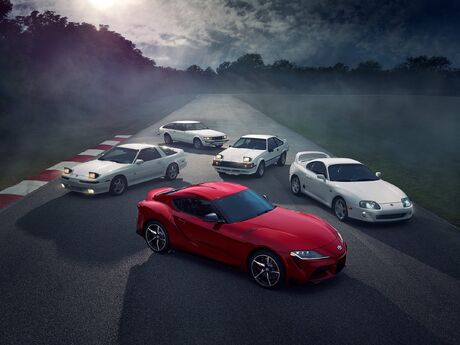
The Toyota Celica Supra is a sports car/grand tourer produced by Japanese car manufacturer Toyota Motor Company from 1979 to the present day. The styling of the Toyota Celica Supra was derived from the Toyota Celica, but it was both longer and wider.[1] Starting in mid-1986, the Supra (in its third generation, MKIII) became its own model and was no longer based on the Celica. In turn, Toyota also stopped using the prefix Celica and began just calling the car Supra.[2] Due to the similarity and past of the Toyota Celica's name, it is frequently mistaken for the Toyota Supra, and vice versa.
The Supra also traces much of its roots back to the Toyota 2000GT with the main instance being its engine. The first three generations were offered with a direct descendant to the 2000GT's M engine. All four generations of Supra produced have an inline 6-cylinder engine, one of the few piston engine configurations with theoretically perfect mechanical balance, leading to very low vibration from the engine.
The name is a combination of Celica and the word Supra. "Celica" is derived from Latin and its literal translation is "celestial" or "from the heavens". "Supra" is a word that is derived from Latin that stands for "over, above, beyond, or greater than". Therefore, a translation to English would be something like "from above the heavens" for the entire term.
Along with this name and car Toyota also included its own logo for the Supra. It is derived from the original Celica logo (it's just orange instead of blue). Often people think it is some sort of swan, but it more closely resembles a dragon. The logo was on Supras until 1989 when Toyota switched to its current oval company logo.
In 1999, Toyota ceased sales of the Supra in the United States[2] and in 2002 Toyota officially stopped production of the Supra in Japan. Toyota officially re-released the Supra for the 2021 model year
Mark I (1979-1981)
| Toyota Celica Supra MK I | |
|---|---|
| Toyota | |
| aka | Mk. I |
| Production | 1979 - 1981 |
| Class | |
| Body Style | |
| Length | 181.7 in (4615.2 mm) |
| Width | 65.0 in (1651.0 mm) |
| Height | 50.8 in (1290.3 mm) |
| Wheelbase | 103.5 in (2628.9 mm) |
| Weight | 2800 lb (1270.1 kg) |
| Transmission | 5-speed W50 manual 4-speed A40D automatic 4-speed A43D automatic |
| Engine | 2.0 L (1988 cc) M-EU I6 2.0 L (1988 cc) M-TEU I6 2.6 L (2563 cc) 4M-E I6 2.8 L (2759 cc) 5M-E I6 |
| Power | |
| Similar | |
| Platform | MA4x |
| Fuel Capacity | 16.1 U.S. GAL (60.4 L) [3] |
| Designer | |
The first generation Supra was based largely upon the Toyota Celica liftback, but was longer by 5.1 in (129.5 mm). The doors and rear section stayed the same length as Celica but the rear panels differed. The most important change was the swap to an Inline-6 instead of the stock Celica's 4-cylinder engine. Toyota's original plan for the Supra at this time was to make it a competitor to the very popular Datsun (now Nissan) Z-car.
1979
In 1978 Toyota began production of the Mark I Supra in Japan. The year it debuted in the United States and Japan was in 1979. The USA Mark I (chassis code MA46) was originally equipped with a 110 hp (82 kW) 2.6 L (2563 cc) 12-valve SOHC inline-6 engine (4M-E). Simultaneously in 1979, the Japanese Mark I (chassis code MA45) was offered with a 110 hp (82 kW) 2.0 L 12-valve SOHC inline-6 engine (M-EU). Both were the first Toyota engines equipped with electronic fuel injection.[2][4]
Drivetrain options for the Mark I were either a 5-speed manual (W50) or an optional 4-speed automatic transmission (A40D). Both transmissions featured an overdrive gear. The top gear in the 5-speed was its overdrive gear whereas the automatic transmission featured an overdrive gear that would engage at speeds of over 35 mph. The drivetrain for the Supra retained the T series solid rear axle configuration of the Celica in the Japanese MA45 version and a larger F series (and optional Limited Slip Differential) in the MA46 and MA47. The car also came standard with 4-wheel disc brakes and featured a four-link rear suspension with coil springs, lateral track bar, and stabilizer bar. The front suspension consisted of MacPherson struts and a stabilizer bar.
On the inside of the Supra one had an option of power windows and power locks as part of the convenience package. The convenience package also included cruise control and special door trim with door pull straps, with an optional sunroof. As for standard features, in the center console there was an extendable map light and a fliptop armrest, which provided storage. Some other features were the tilt steering wheel, deep zippered pockets on the backs of the front seats, and tonneau cover under the liftback. The dashboard also contained a state-of-the-art (at the time) AM/FM/MPX 4-speaker stereo radio, analog clock, and tachometer as part of the instrument panel.
1980
In 1980, the Japanese Mark I (also branded with the MA46 chassis code) was offered with a 145 hp (108 kW) 2.0 L (1988 cc) 12-valve SOHC Turbocharged inline-6 engine (M-TEU). The engine was equipped with a Garrett T03 Turbo, but was not intercooled. This was the first Toyota engine to utilize a turbocharger.[4]
The changes for the 1980 US version were different, but mostly cosmetic. The interior received a redesigned center console and a digital quartz clock. On the exterior were redesigned side view mirrors, the 14x5.5 aluminum rims, which were optional in 1979, are now standard (the 1979s had steel rims with plastic wheel covers standard). In addition body molded mudflaps became available. On the copper metallic and white cars the mudflaps were painted the body color while the mudflaps were left black on all other colors. On the rear of the mudflaps, the word "Celica" was painted in white lettering.[5]
The official Toyota Supra Site[2] also notes that there was an addition of optional leather-trimmed seating and automatic climate-control.
1981
In the coming year, 1981, the Supra received an upgrade in displacement with the 2.8 L (2759 cc) 5M-E engine. It is still a 12-valve SOHC engine, but makes 116 hp (87 kW) and 145 ft·lbf (197 N·m) of torque. The cars automatic transmission was changed to the revised Toyota A43D and it gained a revised final drive gearing. Because of the change in engine and transmission they dubbed a new chassis code of MA47. The final year of the MK I Supra it achieved a 0-60 MPH time of 10.24 seconds and finished the 1/4 mile in 17.5 seconds at 77.7 MPH.[3]
Also in 1981, a new Sports Performance Package became an option, which included sport suspension, raised white letter tires, and front and rear spoilers. This also marked the last year that the 8-track cartridge was offered on any Supra.[2][5]
Quick Info
| Code | Year | Engine | Power | Torque | Transmission | Market |
|---|---|---|---|---|---|---|
| MA45 | 1979 | 2.0 L (1988 cc) M-EU I6 | 110 hp (82 kW) | 136 ft·lbf (184 N·m) | 5-speed W50 manual 4-speed A40D automatic |
JPN |
| MA46 | 2.6 L (2563 cc) 4M-E I6 | 110 hp (82 kW) | 136 ft·lbf (184 N·m) | USA | ||
| 1980 | 2.0 L (1988 cc) M-TEU turbo I6 | 145 hp (108 kW) | 156 ft·lbf (211 N·m) | JPN | ||
| 2.6 L (2563 cc) 4M-E I6 | 110 hp (82 kW) | 136 ft·lbf (184 N·m) | USA | |||
| MA47 | 1981 | 2.8 L (2759 cc) 5M-E I6 | 116 hp (87 kW) | 145 ft·lbf (197 N·m) | 5-speed W50 manual 4-speed A43D automatic |
JPN USA |
Gallery
Mark II (1982-1986)
| Toyota Celica Supra MK II | |
|---|---|
| Toyota | |
| aka | Mk.II Toyota Celica XX |
| Production | 1982 - 1986 |
| Class | |
| Body Style | |
| Length | 183.5 in (4660.9 mm) |
| Width | 67.7 in (1719.6 mm) |
| Height | 52.0 in (1320.8 mm) |
| Wheelbase | 102.9 in (2613.7 mm) |
| Weight | 3000 lb (1360.8 kg) |
| Transmission | 5-speed W58 manual 4-speed A43DL automatic 4-speed A43DE automatic |
| Engine | 2.0 L (1988 cc) M-TEU I6 2.0 L (1988 cc) M-TE I6 2.0 L (1988 cc) 1G-EU I6 2.0 L (1988 cc) 1G-GEU I6 2.8 L (2759 cc) 5M-E I6 2.8 L (2759 cc) 5M-GE I6 |
| Power | |
| Similar | |
| Platform | MA6x GA6x |
| Fuel Economy | 18-21 MPG city 20-28 MPG hwy |
| Fuel Capacity | 16.1 U.S. GAL (60.4 L) |
| Designer | |
In 1982, Toyota completely redesigned the Celica Supra as well as the entire Celica lineup. In Japan, they were known as Celica XX, but everywhere else the Celica Supra name stuck. Still being based around the Celica platform, there were several key differences, most notably the design of the front end and fully retractable pop-up headlights. Other differences would be the inline-6 still present in the Supra instead of the inline-4 as well as an increase in length and wheel base to conform with the overall larger engine.
L-type and P-type
In the North American market, the Celica Supra was available in two distinct models to accommodate any persons tastes. There was of course the Performance Type (P-type henceforth) and the Luxury Type (L-type henceforth). While being mechanically identical, they were differentiated by the available options; tire sizes, wheel sizes, and body trim. The P-type had fiberglass fender flares over the wheel wells, while the L-type did not. The P-type was also standard with the more sporty 8-way adjustable seats. The P-type did not get the option of a leather interior until 1983. All editions of the P-Type had the same 14x7 aluminum alloy rims and throughout the years the L-Type had 14"x5.5" rims until 1985 when they were changed to a P-type style 15x6. The L-type also had the option of a digital dash with trip computer, whereas the P-Type was only offered with an analog dash (with digital clock). The digital dash featured a digital tachometer, digital speedometer, and electronic fuel level and coolant level gauges. The trip computer could calculate and display various things such as fuel economy in miles-per-gallon, estimated time of arrival (ETA), and distance remaining to the chosen destination. Excluding the 1982 model, all P-types were available with headlight washers as an option, but the L-types were never fitted with such an option. Although gear ratios changed throughout the years all P-types came as standard with a limited slip differential.
1982
In the North American market, the Celica Supra's engine was the 2.8 L (2759 cc) 12-valve (2 valves per cylinder) DOHC 5M-GE. Power output was 145 hp (108 kW) and 155 ft·lbf (210 N·m) of torque. The engine utilized an 8.8:1 compression ratio to achieve the power and featured a vacuum advanced distributor. When the car debuted it clocked a 0-60 time of 9.8 seconds and netted a 17.2 second 1/4 at 80 MPH[6]
The standard transmission for this year was the W58 5-speed manual with the A43DL 4-speed automatic transmission being an option for L-types. Both transmissions featured an overdrive gear and the automatic featured a locking torque converter. The top gear in the 5-speed was its overdrive whereas the automatic transmission featured an overdrive gear that would engage at speeds over 35 mph. The 1982 models' rear differential featured a 3.72:1 ratio. The Celica Supra's 4-wheel independent suspension was specially tuned and designed by Lotus and featured variable assisted power rack-and-pinion steering and MacPherson struts up front. As for the rear, it had semi-trailing arm suspension with coil springs and a stabilizer bar. Braking on the Celica Supra was handled by 4-wheel disc brakes.
On the inside this generation had standard power windows, power door locks, and power mirrors as well as a tilt steering wheel. The power door lock was located in the center console next to the power mirror control. The analog dash of this year only went to 85 mph in North America. The optional automatic climate control on the MK I was renovated and was now seen as a standard feature on the MK II. Cruise control was standard in this generation. Toyota also included the retractable maplight as standard, just like with MK I Supras. Some options included the addition of a sunroof, two-tone paint schemes, and 5-speaker AM/FM/MPX tuner with cassette. The optional cassette stereo featured a 105-watt power amplifier and a 7-channel graphic equalizer to control tone. The standard stereo was a 5-channel AM/FM/MPX tuner. Leather was an option on L-Types this year, but P-types were stuck with standard striped cloth.
As far as the outside goes there was no external antenna it was simply located in the front windshield. There was a key lock on the gas tank door and the hatch and bumper were black no matter what color the rest of the car was. The P-types were available with an optional rear sunshade above the hatch glass. The lights in the rear featured a reverse light in the center and the door handles opened the doors by pulling sideways. The front nose badge and B-pillar only read "SUPRA". Although it is believed mudflaps weren't introduced on this generation until 1983, all L-types had front and rear mudflaps.
1983
For the 1983 models not much was altered, but there was an increase in power output to: 150 hp (112 kW) and 159 ft·lbf (216 N·m) of torque from the same 5M-GE. The only real change in the engine area was the switch to an electronic advanced distributor, yet that did not increase the power. Toyota switched to a 4.10:1 rear gear ratio for the P-Type and a 3.73:1 for the L-Type. As for the optional automatic transmission they switched out the A43DL 4-speed for a newly designed A43DE 4-speed. It featured an electronic controller that would adjust its shift pattern for a balance between performance and economy. It was the first in the industry to provide an "Electronically Controlled Transmission" (ECT). This allowed the driver to choose either the "Power" driving mode or "Normal" driving mode at the touch of the button. The "Power" mode provided the quickest acceleration and the "Normal" mode provided the best all-around performance.
On the inside of the car there were virtually no changes, but on the outside they decided to switch to a power antenna and it was the first year both the P-Type and L-Type had standard mudflaps. The B-pillar and nose badge were changed to say "Celica Supra" now and only L-Types were available in two-tone color schemes.
1984
In 1984, Toyota changed quite a bit on the Supra. Power output was increased on the 5-speed models with a bump up to 160 hp (119 kW) and 163 ft·lbf (221 N·m) of torque. The increase was achieved by a mixture of a redesigned intake manifold with "D"-shaped intake runners and an increase in compression ratio to: 9.2:1Cite error: Closing </ref> missing for <ref> tag
Other changes would be a redesigned, more "integrated" sunshade and spoiler on the rear hatch. The rear spoiler was changed from a one piece to a two piece spoiler. Oddly the L-types of this year were not available with a leather interior, but P-types were. Toyota added a standard factory theft deterrent system and the outside mirrors were equipped with a defogger that activated with the rear defroster. All Supras this year received automatic-off lights that also encompassed an automatic illuminated entry and fade-out system.
While 1985 was to be the last year of the second generation model, delays in production of the third generation model led to a surplus of second generation Supras. During the first half of 1986 the 1985 MK II P-type was still offered for sale, with only minor cosmetic changes as well as the addition of a now mandatory rear-mounted third brakelight on the hatch. These were all labeled officially as 1986 models. P-types were the only model available in 1986.
MK IIs around the world
The second generation Supra came in a variety of options around the world as well as only being offered during select years.
Most of Europe
- Sold from 1982-1986.
- 82-83: 2.8 L (2759 cc) DOHC 5M-GE 174 hp (130 kW) and 207 ft·lbf (287 N·m) of torque. Analog dash, no fender flares.
- 84-86: 2.8 L (2759 cc) DOHC 5M-GE 178 hp (133 kW) and 212 ft·lbf (281 N·m) of torque. Digital dash, P-Type fender flares.
Great Britain
- Sold from 1982-1986.
- 82-83: 2.8 L (2759 cc) DOHC 5M-GE 178 hp (133 kW) and 212 ft·lbf (281 N·m) of torque. Analog dash, no fender flares.
- 84-86: 2.8 L (2759 cc) DOHC 5M-GE 178 hp (133 kW) and 212 ft·lbf (281 N·m) of torque. Digital dash, P-Type fender flares.
Australia, Sweden, & Switzerland
- Sold from 1984-1986.
- 2.8 L (2759 cc) SOHC 5M-E 116 hp (87 kW) and 145 ft·lbf (197 N·m) of torque.
- In Australia, the Toyota Supra manufactured between 1982-1990, was assessed in the Used Car Safety Ratings 2006 as providing "worse than average" protection for its occupants in the event of a crash.
New Zealand
- Sold from 1984-1985
- 2.8 L (2759 cc) DOHC 5M-GE 178 hp (133 kW) and 212 ft·lbf (281 N·m) of torque. Digital dash, P-Type fender flares.
Japan
Script error: The function "further" does not exist.
Quick Info
| Code | Year | Engine | Power | Torque | Transmission | Market |
|---|---|---|---|---|---|---|
| MA61 | 1982-1983 | 2.8 L (2759 cc) 5M-GE I6 | 174 hp (130 kW) | 207 ft·lbf (287 N·m) | 5-speed W58 manual 4-Speed A43DL automatic (1982) 4-Speed A43DE automatic (1983) |
EUR GBR |
| 2.8 L (2759 cc) 5M-GEU I6 | 160 hp (119 kW) | 150 ft·lbf (203 N·m) | 5-speed W58 manual | JPN | ||
| 1984-1986 | 2.8 L (2759 cc) 5M-E I6 | 116 hp (87 kW) | 145 ft·lbf (197 N·m) | 5-speed W58 manual 4-Speed A43DE automatic |
AUS CHE SWE | |
| 2.8 L (2759 cc) 5M-GE I6 | 178 hp (133 kW) | 212 ft·lbf (281 N·m) | EUR GBR NZL | |||
| 2.8 L (2759 cc) 5M-GEU I6 | 160 hp (119 kW) | 150 ft·lbf (203 N·m) | 5-speed W58 manual | JPN | ||
| MA63 | 1982 | 2.0 L (1988 cc) M-TEU turbo I6 | 145 hp (108 kW) | 156 ft·lbf (211 N·m) | 4-Speed A43D Automatic | JPN |
| 1983-1985 | 2.0 L (1988 cc) M-TEU turbo I6 | 160 hp (119 kW) | 170 ft·lbf (230 N·m) | |||
| MA67 | 1982 | 2.8 L (2759 cc) 5M-GE I6 | 145 hp (108 kW) | 155 ft·lbf (210 N·m) | 5-speed W58 manual 4-Speed A43DL automatic |
CAN USA |
| 1983 | 2.8 L (2759 cc) 5M-GE I6 | 150 hp (112 kW) | 159 ft·lbf (216 N·m) | 5-speed W58 manual 4-Speed A43DE automatic | ||
| 1984 | 2.8 L (2759 cc) 5M-GE I6 | 160 hp (119 kW) | 163 ft·lbf (221 N·m) | 5-speed W58 manual | ||
| 2.8 L (2759 cc) 5M-GE I6 | 150 hp (112 kW) | 159 ft·lbf (216 N·m) | 4-Speed A43DE automatic | |||
| 1985-1986 | 2.8 L (2759 cc) 5M-GE I6 | 161 hp (120 kW) | 169 ft·lbf (229 N·m) | 5-speed W58 manual 4-Speed A43DE automatic | ||
| GA61 | 1982-1985 | 2.0 L (1988 cc) 1G-EU I6 | 125 hp (93 kW) | 127 ft·lbf (172 N·m) | 5-speed W58 manual 4-Speed A43DL automatic |
JPN |
| 1982-1985 | 2.0 L (1988 cc) 1G-GEU I6 | 160 hp (119 kW) | 134 ft·lbf (181 N·m) | 5-speed W58 manual |
Gallery
Mark III (1986 1/2-1992)
| Toyota Supra MK III | |
|---|---|
| Toyota | |
| aka | Mk. III |
| Production | 1986 1/2 - 1992 |
| Class | |
| Body Style | |
| Length | 182.3 in (4630.4 mm) |
| Width | 68.7 in (1744.9 mm) |
| Height | 51.2 in (1300.5 mm) |
| Wheelbase | 102.2 in (2595.9 mm) |
| Weight | 3500 lb (1587.6 kg) |
| Transmission | 5-speed W58 manual 5-speed R154 manual 4-Speed A340E automatic |
| Engine | 2.0 L (1988 cc) 1G-GTE I6 2.5 L (2491 cc) 1JZ-GTE I6 3.0 L (2954 cc) 7M-GE I6 3.0 L (2954 cc) 7M-GTE I6 |
| Power | |
| Similar | |
| Platform | MA7x GA7x JZA7x |
| Fuel Economy | 17 MPG city 23 MPG highway [7] |
| Fuel Capacity | 18.5 U.S. GAL (70.0 L) [7] |
| Designer | |
In the middle of 1986, Toyota was ready to release its next version of the Supra. The official model year is designated as 1986.5. The bonds between the Celica and the Supra were cut; they were now two completely different kinds of models. The Celica changed to front wheel drive, while the Supra kept its rear wheel drive platform. Though the Mark II and Mark III had similar designs, the engine was updated to a more powerful 3.0 L straight 6. Although only available in naturally aspirated trim in 1986.5, a second version of the engine was introduced in 1987 which featured a turbocharger.
The new Mark III Supra engine was the flagship engine of Toyota's arsenal. Both versions of the engine contained 4 valves per cylinder and dual overhead cams. The turbocharged 7M-GTE engine was Toyota's first distributor-less engine offered in the U.S.and was rated at 232 hp (173 kW) at 5600 RPM while the naturally-aspirated 7M-GE engine was rated at 200 hp (149 kW) at 6000 RPM.
The naturally aspirated came as standard issue with the W58 manual transmission. The turbo versions included the more robust R154 manual transmission. Both were available with the optional 4-speed A340E automatic transmission.
During the year of 1989, the car received new tail lights, a front bumper, badging and side trim amongst other features. Modifications to the wastegate and engine management netted another 2 hp on the turbo model. For the 1991 model year, the wheel design was changed to 5-spoke wheels. Both models wore 16x7 aluminium alloy wheels that were fitted with 225/50/16 tires and full-sized spares on steel wheels.
The A70 Supra was also available in two non-export models in Japan, the JZA70 with a 2.5 L 280 hp (209 kW) twin-turbo 1JZ-GTE, known as 2.5GT Twin Turbo (JZA70), and with a 2.0 L 210 hp (157 kW) twin-turbo 1G-GTE. A special version of the 1JZ-GTE equipped JZA70, the 2.5 Twin Turbo R, had black/grey Recaro seats.
The third-generation Supra represented a great deal of new technology. In 1986, Supras were already equipped with 4-channel ABS and TEMS (Toyota Electronically Modulated Suspension) which gave the driver 2 settings which affected the damper rates. All models were fitted with double wishbone suspensions front and rear. A targa top was offered along with a metal power sliding sunroof (added in '91).
The 7M-GTE MA70 is capable of propelling itself 0-60 mph in 6.2 seconds with 6.8 psi of boost. It reached the 1/4 mile in 14.7 seconds at a speed of 95 mph. Its top speed is 149 mph.
Turbo A
- Main article: Toyota Supra Turbo-A
In 1987, the Turbo-A model was introduced as a 1988 model. It was a special design aimed at winning the Group-A touring car championships around the world. There were only 500 Turbo-As ever made. The Turbo-A was a special 7M-GTE with 267 PS (263 hp/196 kW), making it the fastest Japanese road car until the Nissan Skyline R32-GTR was introduced in 1989. The Turbo-A model was only produced in black, featured a grey leather interior, a larger intercooler, and used speed/density (MAP + IAT sensor) air metering. In addition, it was a hardtop model and featured a larger compressor wheel on the CT-26(A) turbocharger and throttle body.
Quick Info
| Code | Year | Engine | Power | Torque | Transmission | Market |
|---|---|---|---|---|---|---|
| MA70 | 1986.5-1992 | 3.0 L (2954 cc) 7M-GE I6 | 200 hp (149 kW) | 196 ft·lbf (265 N·m) | 5-speed W58 manual 4-speed A340E automatic |
CAN EUR USA |
| 3.0 L (2954 cc) 7M-GTE turbo I6 | 232 hp (173 kW) | 240 ft·lbf (325 N·m) | 5-speed R154 manual 4-speed A340E automatic |
CAN EUR JPN | ||
| MA71 | 1987-1992 | 3.0 L (2954 cc) 7M-GTE turbo I6 | 232 hp (173 kW) | 240 ft·lbf (325 N·m) | 5-speed R154 manual 4-speed A340E automatic |
USA |
| GA70 | 1986.5-1992 | 2.0 L (1988 cc) 1G-GTE turbo I6 | 185-210 hp (138-157 kW) | 173-203 ft·lbf (234-275 N·m) | 5-speed W58 manual 4-speed A340E automatic |
JPN |
| JZA70 | 1986.5-1992 | 2.5 L (2491 cc) 1JZ-GTE turbo I6 | 280-300 hp (206-221 kW) | 268-272 ft·lbf (363-368 N·m) | 5-speed R154 manual 4-speed A340E automatic |
JPN |
Gallery
Mark IV (1993-2002)
| Toyota Supra MK IV | |
|---|---|
| Toyota | |
| aka | Mk. IV |
| Production | 1993 - 2002 |
| Class | Mid-sized Sports |
| Body Style | 2 dr 2+2 Coupe |
| Length | 177.7 in (4513.6 mm) |
| Width | 71.3 in (1811.0 mm) |
| Height | 50.2 in (1275.1 mm) |
| Wheelbase | 100.4 in (2550.2 mm) |
| Weight | non-turbo: 3210 lb (1460 kg) turbo: ~3400 lb (1542.2 kg) |
| Transmission | 5-speed W58 manual 6-speed V16x manual 4-Speed A341E automatic |
| Engine | 3.0 L (2997 cc) 2JZ-GE I6 3.0 L (2997 cc) 2JZ-GTE I6 |
| Power | 221 bhp @ 6000 rpm 29.00kgf.m @ 4800 rpm |
| Similar | Mitsubishi GTO |
| Platform | JZA8x |
| Fuel Economy | 18 MPG city 23 MPG highway[8] |
| Fuel Capacity | 18.5 U.S. GAL (70.0 L)[8] |
| Assembly | Motomachi, Japan[9] |
| Designer | |
With the fourth generation of the Supra, Toyota took a big leap in the direction of a more powerful sports car. The new Supra was completely redesigned, with rounded body styling partly based on the Ferrari F40 and featured two new engines: naturally aspirated 2JZ-GE 220 hp (164 kW) and 210 ft·lbf (285 N·m) of torque and a twin turbocharged 2JZ-GTE making 276 bhp (239 kW), 315 ft·lbf (427 N·m) of torque. The Turbo was actually quoted to have 320 bhp, as the cars in the Japan market can only declare up to 276. The turbocharged variant could achieve 0–60 mph in as low as 4.6 seconds and 1/4 mile (402 m) in 13.1 seconds at 109 mph [8]. The engine is capable of producing around 400hp with the stock twin turbos and mild bolt-on upgrades such as a boost controller and high-flow exhaust. The turbo version was tested to reach over 289 kph (180 mph) all-stock, but the cars are restricted to just 180 kph in Japan and 250 elsewhere. European versions also had a hood scoop.
The MKIV Supra's twin turbos operated in sequential mode instead of the more common parallel mode. The sequential setup featured a pair of small, equally sized turbos, with ceramic blades for the domestic Japanese market and steel blades for export (USA, Europe) markets. At first, all of the exhaust is routed to the first turbine for reduced lag. This resulted in boost and enhanced torque as early as 1800 rpm. Approaching 4000 rpm, the exhaust is routed to the second turbine for a "pre-boost" mode, although none of the compressor output is used by the engine at this point. Approaching 4500 rpm, the second turbo's output is added to the intake air, and both turbos operate in parallel. Most cars which are advertised as "twin turbo" operate by having the two equally sized turbos constantly running in parallel; the turbos spool up at the same time. The sequential mode provides greater low-end response at the expense of increased complexity and cost.
For this generation, the Supra received a new 6-speed Getrag transmission on the Turbo models while the naturally aspirated models made do with a 5-speed manual. Both models were offered with a 4-speed automatic with a manumatic mode. However, the turbo model used larger 4-piston brake calipers on the front and 2-piston calipers for the rear. The base model used smaller 2-piston calipers for the front and a single piston caliper for the rear. The turbo models were fitted with 235/45/17 tires on the front and 255/40/17 tires for the rear. The base model used 225/50/16 for the front and 245/50/16 for the rears. All vehicles were equipped with 5-spoke aluminium alloy wheels and a "donut" spare tire on a steel wheel. Additionally, there are other differences in the rear axle differential, headlight assemblies, throttle body, oil cooler and a myriad of additional sensors that exist on the turbo model which doesn't exist on the normally aspirated model.
Toyota took measures to reduce the weight of the current model compared to the previous model. The Supra featured hollow carpet fibers. Aluminium was used for the hood, targa top (if so equipped), front crossmember, oil pan, and the suspension upper A-arms. Other measures included dished out head bolts, magnesium steering wheel, plastic gas tank and lid, gas injected rear spoiler, and a large single exhaust tip. Despite having more features such as dual airbags, traction control, larger brakes, larger wheels, and larger tires, the car was at least 100-200 lbs lighter than its predecessor.
For the 1996 model year, the turbo model was only available with the automatic transmission due to OBD2 certification requirements. The targa roof was made standard on all turbo models. For 1997, the manual transmission is back for the optional engine along with a redesign of the tail lights, front fascia, chromed wheels, and other minor changes such as the radio and steering wheel designs. All 1997 models included badges that said, "Limited Edition 15th Anniversary." For 1998, the radio and steering wheel were redesigned once again. The naturally aspirated engine was enhanced with VVTI which raised the output by 5 hp and 10 ft·lbf of torque. The turbo model was not available in California, New York, and Massachusetts due to increased emission regulations.
MKIV Supras have been modified (larger turbos running 30+ psi (206 kPa) of boost and other, undisclosed tweaks) to produce over 1453bhp (1084 kW), as measured at the tires, and cover the 1/4 mile (402 m) in 7.9 seconds. The stock 2JZ-GTE stock engine components are astonishingly rugged, capable of withstanding power outputs of over 1000 bhp (~850rwhp dynojet / ~730rwhp dyno dynamics) without having to update any internal components, putting its capabilities in this regard, somewhat above Nissans legendary RB26 series engine. The stock MKIV Supra chassis has also proven a very effective platform for roadracing, with (for example) several top 20 and top 10 One Lap Of America finishes in the SSGT1 class. The major deficiencies with this platform for road racing include heat management and weight due to the 2JZ iron block. The Supra is one of the heaviest 2-door Japanese sports cars, however still slightly lighter than the Nissan R33 and R34 Skyline GTRs to which the Supra is traditionally a rival in its home country.
The MKIV has become one of the most popular import platforms for modification. This trend has largely been driven by the strength of the stock parts. Untouched motors have been shown to withstand power levels in excess of 3 times what the stock motor is rated at. For less than USD$1000 the owner can increase the power output from 320 crank horsepower (stock) to around 500 crank horsepower. The car has also been hyped and glamourised in several major motion pictures, to a widely mixed reception depending mostly on the age of audience. In the drag racing circuit, Supras and other 2JZ-powered cars have been running very competitively against domestics with two or three times the displacement. The 2JZ has been recognized as one of the most capable import engines, and the engine design has altered very little since the 2JZ was released in 1992.
In 1998, Toyota ceased to import the cars to the U.S. from Japan, although the car was last sold in Canada in 1995. They stopped production of the car altogether in August 2002 due to new emission standards coming into effect in 2003.
Gallery
Mark V
| Toyota Supra MK V | |
|---|---|
| Toyota | |
| aka | Mk. V |
| Production | 2020- |
| Class | Sports |
| Body Style | 2 door coupe |
| Length | 4,380 mm (172.4 in) |
| Width | 1,865 mm (73.4 in) |
| Height | 1,290–1,295 mm (50.8–51.0 in) |
| Wheelbase | 2,470 mm (97.2 in) |
| Weight | 1,410–1,520 kg (3,109–3,351 lb) |
| Transmission | 8-speed ZF 8HP automatic |
| Engine | 1,998 cc (1.998 L; 121.9 cu in) BMW B48B20 turbocharged I4
2,998 cc (2.998 L; 182.9 cu in) BMW B58B30 turbocharged I6 |
| Power | |
| Similar | BMW Z4 |
| Designer | Tetsuya Tada (2012) |
Throughout the past couple of years, major print and online auto publications have hinted at a possible revival of the Supra in 2007/2008, pointing the car in different directions. The vehicle was originally thought to be the flagship or halo model in the Toyota lineup, be powered by a high output V8, and have an estimated cost anywhere between $50,000 and $70,000. Other rumors hint at a V10 F1-inspired powerplant, like the current BMW M5 and M6, though current F1 engines have been downgraded to V8s. Power is likely 450 bhp or more, as this was likely due to the increasing number of sighting of a high performance sports car being tested throughout Europe and, more specifically, on the Nürburgring. These vehicles turned out to be the test mules for Lexus' future Lexus LF-A.[10]
After this was discovered, it was then believed that that if a new Supra were to be released, it will be positioned to compete directly against the Nissan Skyline. It was expected to be available as a coupe and convertible, have a V6 producing around 350+ hp, and cost between $25,000 and $35,000. Throughout recent years, different publications as well as fans of the Supra have created several renditions of what a new Supra might look like if it were ever to be produced.
Topspeed.com was among a number of publications that claimed that there will be a return of the Supra in 2008 [11] but Toyota disclaimed this rumor on August 15, 2006. The same numerous publications that originally speculated on a future Supra all stated no new vehicle was being developed. According to an AutoWeek article on current and upcoming Toyota vehicles, all rumors on the Supra's return are false.[12] Automotive News also claim Toyota has absolutely no plans for a Supra in the future.[13]
- " All the rumors of the two-passenger sports car's return are false." - Automotive News[13]
The Toyota FT-HS (Future Toyota-Hybrid Sport),[14] set to debut at the 2007 North American International Auto Show, was stated to be a concept for a vehicle that could fill the gap in Toyota's line-up left by the Supra.[15]
In 2010, Toyota applied for a trademark to the Supra name. The trademark had to be used within three years for it to be valid.[16] In December 2011, Autoguide reported a possible Supra replacement that would sit above the GT86.[17] Tetsuya Tada, the chief engineer of the Toyota 86/Scion FR-S told reporters in Germany in 2012 "the president (Akio Toyoda) has asked me to make a successor to the Supra as soon as possible."[18]
In late 2013, AutoBlog reported a Supra successor concept would be making its debut the January 2014 North American International Auto Show.[19] On 13 January, Toyota unveiled its new FT-1 concept car. Little is known about this new concept car; other than that it has a front engine and rear wheel drive layout. Toyota also stated that their new concept car draws inspiration from Toyota's past sports cars like the 2000GT, Supra, MR-2, and 2007 FT-HS concept car. Toyota did not state whether the FT-1 would use the Supra name, or if it was even bound for production. However, Toyota did state if the FT-1 is approved from production, a price tag of around $60,000 was to be expected for each unit.[20]
On 10 February 2014, Toyota submitted an application to the United States Patent and Trademark Office to renew the Supra trademark.[21]
In June 2016, a trademark application for the Supra nameplate was filed with the European Union Intellectual Property Office.[22] According to Autocar, the new Supra was set to debut in 2018.[23] The publication reported that the car would likely feature rear wheel drive; four-cylinder engines were expected to be available, and it had been confirmed that the car would offer a turbocharged inline-6 engine.[24] It was believed that these engines would be supplied by BMW.[25] Kleine Zeitung reported that the new jointly-developed Supra will be produced at a Magna Steyr facility near Graz, Austria, along with the BMW Z4 (G29).[26] Although the sports car's name was yet to be officially confirmed, Toyota global chief engineer Tetsuya Tada said that it will likely carry the nameplate Supra, due to its name recognition and historical significance.
On 5 July 2018, Toyota Racing announced that the Supra would return to production and compete in the US NASCAR Xfinity Series in 2019.[27]
On 12 July 2018, a near-production model of the fifth generation of the Supra was unveiled (in camouflage) at the Goodwood Festival of Speed.[28]
Launch
The fifth generation of the Supra made its debut at the January 2019 North American International Auto Show as a 2020 model.[29][30][31][32][33][34][35][36] The first production model was auctioned at a price of $2.1 million at Barrett-Jackson auction in January 2019, with 100% of the money going to the American Heart Association and the Bob Woodruff Foundation.[37][38] The auction car has a one-off matte grey exterior color which is not offered on the standard Supra, as well as a red interior, metallic black 5-bolt wheels, red wing mirrors, a signature from Toyota CEO Akio Toyoda on the dashboard and VIN number 20201.[39] Sales for the production car will begin sometime around the first quarter of 2019 with an expected price tag of $50,920 in the United States.[40]
The Supra went on sale in Japan on 17 May 2019. In the United States, sales began on 22 July 2019 with a starting base price tag of US$49,990. In Australia, sales began on 2 September 2019.
Engine
The Supra is powered by two BMW-sourced engine options: a turbocharged 2.0-liter inline-four or a turbocharged 3.0-litre inline-six engine. The 2.0-litre engine is currently not offered for the US market, leaving the 3.0-liter inline-six as the only engine option available. The 2.0-litre engine has a power output of 145–190 kW (194–255 hp; 197–258 PS) from 1,600 to 4,500 rpm, with power sent to the rear wheels through a ZF 8HP 8-speed automatic transmission.[41] A manual transmission option is currently not offered. The 2.0 L model can accelerate from 0–97 km/h (0–60 mph) in 5.2 to 6.5 seconds, while the 3.0 L model can accelerate from 0–97 km/h (0–60 mph) in 4.1 seconds, 1.1 seconds quicker than the turbocharged variant of the A80 Supra and has an electronically limited top speed of 249 km/h or 155 mph.[42] Toyota initially considered to give the new Supra a dual-clutch automatic transmission, but went with the ZF 8HP for its smoothness, reliability, and weight savings. A manual transmission was initially not offered, due to its torque-converter automatic having quick shifts, its ability to handle a lot of torque with self-awareness on its aftermarket potential, and wanting to differentiate it from the 86. A 6-speed manual transmission option will be available in 2022 for the 2023 model year for the six-cylinder engine only. The transmission is a modified ZF unit, and receives a shorter final drive ratio compared to the automatic as well as a rev-matching function.
Before production, Toyota wanted to build a front-engine rear-wheel drive turbocharged inline-six pure sports car that would compete against the Porsche Cayman and be a track and street weapon, all while avoiding supercar prices, while BMW wanted to build a roadster, which gave them the idea of co-developing an all-new platform that would handle both coupe and convertible variants with great rigidity and handling of torque. The platform takes few elements from BMW's M cars that were praised by both Toyota and BMW for their characteristics, such as the suspension design, forged control arms and electronic differential, all while being able to reduce costs for production and the final product. After co-developing the platform together, Toyota and BMW went to develop the rest of the two cars separately, such as chassis development, exterior and interior designs, and tuning of both drivetrain and suspension.
Markets
United States
The US model is offered in two trim levels (excluding the Launch Edition model), which are the 3.0 and 3.0 Premium. The 3.0 model has a 6.5-inch center touchscreen multimedia system with Bluetooth and standard Alcantara trimmed seats, while the 3.0 Premium has a larger touchscreen multimedia system (8.8-inches), standard navigation, wireless Apple CarPlay, 12-speaker JBL stereo sound system, wireless phone charging, color head-up display and heated leather seats. All variants have collision warning, automatic high beams, automatic emergency braking with pedestrian detection, lane departure warning and a feature that recognizes road signs as standard.[43]
The first 1,500 cars sold are the special Launch Edition models, which are based on the 3.0 Premium model and offered in three exterior colour options: Absolute Zero White, Nocturnal Black and Renaissance Red 2.0.[44] Cars that have the white or black exterior colour have the same red interior as the auction car, which is only offered in the Launch Edition models, while the red cars have a black interior. All Launch Edition cars have a red coloured wing mirrors and a replica of Akio Toyoda's signature on a carbon fiber plaque fixed to the dashboard, mirroring the auction car.[45]
For the 2021 model year, two new models, the A91 Edition and the 2.0, will be introduced. For the 3.0, 3.0 Premium, and A91 Edition, the output of the 3-litre engine will be increased to 285 kW (382 hp) and 499 N⋅m (368 lb⋅ft) of torque. The 2.0 will feature the same 2-litre engine used in the SZ and SZ-R models sold in Japan, and is rated at 190 kW (255 hp) and 400 N⋅m (295 lb⋅ft) of torque.
In 2022, for the 2023 model year, the Supra 3.0 and 3.0 Premium will be available with a 6-speed manual transmission, with a limited A91-MT Edition also available.
Japan
The Supra is offered in three trim levels, which are the SZ, SZ-R and RZ. The SZ model is powered by the 145 kW (194 hp; 197 PS) 2.0-litre engine and is equipped with 17-inch single tone wheels, manual seats, black fabric upholstery, dark silver trim and a 4-speaker sound system. The SZ-R model is powered by the 190 kW (255 hp; 258 PS) variation of the 2.0-litre engine and is equipped with 18-inch two tone wheels, eight-way powered seats, Alcantara/black leather upholstery, carbon fibre trim, 8.8-inch touchscreen multimedia system with 12-speaker JBL stereo sound system and a head-up display. The RZ model is powered by the 3.0-litre engine and is equipped with 19-inch two tone wheels. It also has the same interior equipments as the SZ-R model, with the difference being the use of Alcantara/red leather upholstery (black leather is available as an option) and sports pedals. A "Sport" mode and dual-zone climate control system is standard on all three variants, as is the Toyota Supra Connect infotainment system. All variants are also equipped with Toyota Supra Safety suite, which includes autonomous emergency braking, lane departure alert, blind spot monitor, adaptive cruise control and rear-cross traffic alert. GR Parts is also available, including the Toyota Gazoo Racing Recorder, which allows drivers to log their driving data to an SD card. This can be supplemented by an optional dashcam, which synchronises the video with the recorded information.
Motorsport
GR Supra Racing Concept
The GR Supra Racing Concept is a concept racing car that previews the racing version of the fifth generation Supra. It debuted at the March 2018 Geneva Motor Show. The design was inspired from the 2014 FT-1 concept. It features a lowered suspension with Toyota OEM parts, BBS center-lock racing wheels, Brembo racing calipers, a full roll cage and fire extinguisher system, a stripped out interior, Michelin track tires and a center exit racing exhaust. It also features carbon fibre for the hood, splitter, diffuser, mirror caps, side skirts, wing and bumpers. It is unknown what engine powered the concept.
GR Supra GT4
The GR Supra GT4 Concept is a concept racing car that is built for participating in the European GT4 racing series. It was first shown at the March 2019 Geneva Motor Show. Upgrades include reduced weight, upgraded brakes and suspension and the addition of a rear wing and roll cage.
Toyota later unveiled a production model in October 2019, with an engine rated at 320 kW (429 hp; 435 PS). It has a seven-speed automatic, as opposed to the eight-speed unit on standard road going models, and has an Akrapovič exhaust system which enables the increase in power. Inside, an FIA-standard racing seat is present featuring a six-point harness, along with a carbon fibre instrument cluster. Motorsport ABS, a data logger and a fire extinguisher are standard, while an illuminated car number is optional. The GT4 is equipped with six-piston front and four-piston rear brake calipers. Pirelli P Zero racing tires and OZ wheels are fitted, supported by KW dampers. The roll cage and rear wing are also carried over from the concept. Sales began in Europe in March 2020, followed by North America in August 2020 and Japan/Southeast Asia in October 2020.
Gallery
Appearances in Video Games
- Gran Turismo features the turbo MA70 and JZA70 Mark III Supra, both the naturally aspirated and turbo Mark IV Toyota Supra, and the Castrol GT Supra.[46]
- Gran Turismo 2 includes the same cars as the first one along with multiple race versions.[47]
- Gran Turismo 3: A-Spec features both variants of the MK IV Toyota Supra along with multiple race versions of the car. [48]
- Gran Turismo 4 features the Celica XX and it shares the same Supras as the original Gran Turismo; along with more race versions.[49]
- Forza Motorsport includes the MKIII Supra (turbo only) and the MKIV Supra
- The original The Need for Speed includes the MKIV Supra.
- Need For Speed: Underground and Need For Speed: Underground 2 features the Toyota Supra and it can be both driven and modified.
- Need For Speed: Most Wanted features the Toyota Supra. One of the Blacklist rivals drives a MKIV Toyota Supra.
- Need For Speed: Carbon features the Supra as a tier 3 car in the tuner class.
- Midnight Club 3: DUB Edition and Midnight Club 3: DUB Edition Remix also features the Toyota Supra, which it is a C-Class car, yet it can run up to 200 MP/H once heavily upgraded.
- Project Gotham Racing 2 features the Toyota Supra and it can be purchased.
- Grand Theft Auto San Andreas features a likeness of the MKIV Supra, the "Jester". It is rarely seen.
- Street Racing Syndicate features a Celica and Mark IV version of the Supra, rear wheel drive.
- Import Tuner Challenge features the Mark III and Mark IV version of the Supra, both being capable of a triple turbo motor swap with misfiring kits. Also features the Mark III and Mark IV Supras with realistic tuning, steering-wheel views and bodykits.
- Wangan Midnight Maximum Tune features the Mark III and IV versions of the Supra.
- Shutokou Battle (Tokyo Xtreme Racer) features MA70,JZA70,JZA80
- Asphalt 8 Airborne Features the Supra MarkIV
Awards
- The MK II, with its all-new design, quickly became a success in the US where it was awarded the Import Car of the Year by Motor Trend. It also made Car and Driver magazine's Ten Best list for 1983 and 1984.
- In 1994, the MK IV Supra won Popular Mechanics "Design & Engineering awards". [2]
United States Timeline
- 1979 - Celica Supra MK I introduced with 2.6 L (2563 cc) SOHC 4M-E I6 engine.
- 1981 - MK I engine displacement upped to 2.8 L (2759 cc) with SOHC 5M-E I6 engine.
- 1982 - MK II Celica Supra introduced with a 2.8 L (2759 cc) DOHC 5M-GE I6 engine.
- 1986 - 1986.5 MK III Supra introduced on its own platform with 3.0 L (2954 cc) DOHC 7M-GE I6 engine.
- 1987 - Option of turbocharger to 3.0 L (2954 cc) DOHC 7M-GTE engine that produces 230 hp (172 kW) 245 ft·lbf (332 N·m).
- 1989 - Restyled. Turbo power increase to 234 hp (174 kW) 250 ft·lbf (339 N·m).
- 1993 - 1993.5 MK IV Supra introduced with 3.0 L (2997 cc) turbo (2JZ-GTE) or non-turbo (2JZ-GE) DOHC engine.
- 1996 - Turbo only available with Automatic transmission due to OBD2 certification requirements. Targa roof standard on all Turbo models.
- 1997 - Manual transmission available on turbo models. Restyled. All 1997 labeled as 15th Anniversary model. Japanese production stopped in September.
- 1998 - Slight restyling of interior. VVT-i on non-turbo models which increased power. Turbos not available in states that require New York emissions.
- 1999 - Export of MK IV Toyota Supra halted in the U.S., production in Japan continues.
- 2002 - Production of MK IV Toyota Supra halts.
See Also
References
| Wikimedia Commons has media related to: Toyota Supra |
- 1980 Toyota Celica Supra Sales Bruchure PDF
- 1981 Toyota Celica Supra Sales Brochure PDF
- 1982 Toyota Celica Supra Sales Brochure PDF
- 1983 Toyota Celica Supra Sales Brochure PDF
- 1984 Toyota Celica Supra Sales Brochure PDF
- 1985 Toyota Celica Supra Sales Brochure PDF
External links
- SOGI: Supra Owners Group International
- MK I and MK II enthusiasts forum @ celicasupra.com
- JB car pages: Toyota Supra
- MK III specific forum @ supramania.com
- A MK IV Supra enthusiast web site & forum @ mkiv.com
- Supra Forums @ supraforums.com
- ↑ "FAQ: What is the history of the Toyota Supra?". toyota.com. http://toyota.custhelp.com/cgi-bin/toyota.cfg/php/enduser/std_adp.php?p_faqid=4077&p_created=990830954&p_sid=bwsHAPpi&p_accessibility=0. Retrieved 2006-12-22.
- ↑ 2.0 2.1 2.2 2.3 2.4 2.5 "Official Toyota Supra Web Site". Toyota.com. http://www.toyota.com/html/shop/vehicles/supra.html. Retrieved 2006-12-22.
- ↑ 3.0 3.1 "1981 Toyota Celica Supra Road Test Data & Specifications" (JPG). Supra vs. Supra. Motor Trend. February 1982. pp. pg. 46. http://www.celicasupra.com/images/MT2-82-3.jpg. Retrieved 2006-12-22.
- ↑ 4.0 4.1 "The History Of Toyota's M Engines". eds.au.com. http://www4.tpgi.com.au/users/loats/technical/mhistory/mhistory.html. Retrieved 2006-12-22.
- ↑ 5.0 5.1 "MK I Celica Supra History". celicasupra.com. http://www.celicasupra.com/historymki.htm. Retrieved 2006-12-22.
- ↑ "1982 Toyota Celica Specifications" (JPG). Toyota Celica Supra. Car and Driver. October 1981. pp. pg. 42. http://www.celicasupra.com/images/cd10-81-7.jpg. Retrieved 2006-12-22.
- ↑ 7.0 7.1 "1992 Toyota Supra specs, auto safety at Edmunds". edmunds.com. http://www.edmunds.com/used/1992/toyota/supra/11629/specs.html. Retrieved 2006-12-22.
- ↑ 8.0 8.1 8.2 "Specifications and test results" (JPG). Toyota Supra Turbo: Think of it as a Lexus for Smokey Yunick. Car and Driver. March 1993. pp. pg. 41. http://mkiv.com/publications/car&driver/3_93/6-cd3-93.jpg. Retrieved 2006-12-22.
- ↑ "Tech Data" (JPG). Toyota Supra Turbo: Leaner and Meaner. Motor Trend. March 1993. pp. pg. 57. http://mkiv.com/publications/motor_trend/3_93/MotorTrend-Mar-93-4.jpg. Retrieved 2006-12-22.
- ↑ "Lexus LF-A". lexus.ca. http://www.lexus.ca/lexus/experience/en/home/concept/concept_vehicles.jsp. Retrieved 2006-12-22.
- ↑ "2008 Toyota Supra". topspeed.com. http://www.topspeed.com/cars/toyota/toyota-supra-ar6872.html. Retrieved 2006-12-22.
- ↑ "Future Products--Toyota". AutoWeek. 2006-08-15. http://www.autoweek.com/apps/pbcs.dll/article?AID=/20060815/FREE/60814015/1041/TOC01ARCHIVE. Retrieved 2006-12-22.
- ↑ 13.0 13.1 Report: No New Supra - Left Lane News article stating no future Supra is currently being planned
- ↑ 2007 Toyota FT-HS Concept - Latest News, Features, and Auto Show Coverage - Automobile Magazine:
- ↑ It's only a concept car for the Detroit auto show, but it might become the next Supra - accessed December 27, 2006
- ↑ Korzeniewski, Jeremy (30 July 2010). "Report: Toyota secures trademark for Supra name – Autoblog". Autoblog.com. http://www.autoblog.com/2010/07/30/report-toyota-secures-trademark-for-supra-name/. Retrieved 5 October 2010.
- ↑ Siu, Jason (6 December 2011). "Toyota Supra Successor One of Two New Models Being Considered". http://www.autoguide.com/auto-news/2011/12/toyota-supra-successor-one-of-two-new-models-being-considered.html. Retrieved 12 November 2012.
- ↑ Ee, Samuel (13 November 2012). "Report: Toyota to let loose two more sports cars after the 86 – AsiaOne". asiaone.com. Archived from the original on 20 February 2014. https://web.archive.org/web/20140220034044/http://ride.asiaone.com/news/general/story/toyota-let-loose-two-more-sports-cars-after-86. Retrieved 28 January 2014.
- ↑ Miersma, Seyth (December 2013). "Report: Toyota to shock with Supra concept for Detroit Auto Show?". autoblog.com. http://www.autoblog.com/2013/12/06/toyota-supra-detroit-auto-show/. Retrieved 27 January 2014.
- ↑ Reynolds, Kim (13 January 2014). "Toyota FT-1 Concept First Look: Akio's Assault Vehicle: Futuristic Sports Car Melds F1 Influences With Supra Styling". motortrend.com. http://www.motortrend.com/future/concept_vehicles/1403_toyota_ft_1_concept_first_look/. Retrieved 27 January 2014.
- ↑ Collett, Trevor (17 February 2014). "Toyota Supra Name Back on the Table, US Patent Application Filed – The Motor Report". themotorreport.com.au. http://www.themotorreport.com.au/58244/toyota-supra-name-is-back-on-the-table-us-patent-application-filed. Retrieved 17 February 2014.
- ↑ Fink, Greg (6 June 2016). "Supra Man: Toyota Trademarks Iconic Sports Car Name in Europe". Car and Driver. http://blog.caranddriver.com/supra-man-toyota-trademarks-iconic-sports-car-name-in-europe/.
- ↑ Sheehan, Sam (12 July 2016). "New Toyota Supra on course for 2018 launch". http://www.autocar.co.uk/car-news/new-cars/new-toyota-supra-course-2018-launch.
- ↑ Tsui, Chris (7 March 2018). "Production Toyota Supra confirmed to get early 2019 reveal". http://www.thedrive.com/news/19049/production-toyota-supra-confirmed-to-get-early-2019-reveal.
- ↑ Szymkowski, Sean (9 August 2017). "No manual transmission for 2019 Toyota Supra, but 4- and 6- cylinder engines planned". https://www.motorauthority.com/news/1112019_no-manual-transmission-for-2019-toyota-supra-but-4-and-6-cylinder-engines-planned.
- ↑ Taylor, Michael (28 July 2016). "Toyota Supra and BMW Z5: Everything We Know". http://blog.caranddriver.com/toyota-supra-and-bmw-z5-everything-we-know/.
- ↑ The Revival of the Fittest: Toyota Supra Gets Back to American Racing in NASCAR Xfinity Series (Press release). US: Toyota. 5 July 2018. http://toyotanews.pressroom.toyota.com/releases/toyota+supra+gets+back+to+american+racing+in+nascar+xfinity+series.htm. Retrieved 16 July 2018.
- ↑ Template:Cite AV media
- ↑ Toyota Premieres New Supra at Detroit Auto Show (Press release). Japan: Toyota. 14 January 2019. https://newsroom.toyota.co.jp/en/toyota/26144480.html. Retrieved 16 January 2019.
- ↑ Perez, Jeff (14 January 2019). "2020 Toyota Supra Debuts With 335 HP After A Decade Of Foreplay". Motor 1 (US). https://www.motor1.com/news/300869/2020-toyota-supra-horsepower-details/.
- ↑ Lee, Jonathan (15 January 2019). "Toyota GR Supra revealed – first global Gazoo Racing model, 340 PS 3.0L straight-six priced from RM205k". paultan.org (Malaysia). https://paultan.org/2019/01/15/toyota-gr-supra-revealed-first-global-gazoo-racing-model-340-ps-3-0l-straight-six-priced-from-rm205k/.
- ↑ Anderson, Brad (14 January 2019). "2020 Toyota Supra Launch Edition Is Exclusive To 1500 U.S. Buyers, Costs $55,250". Carscoops (US). https://www.carscoops.com/2019/01/2020-toyota-supra-launch-edition-exclusive-1500-u-s-buyers-costs-55250/.
- ↑ Huffman, John Pearley (14 January 2019). "The 2020 Toyota Supra Is a Resurrection of a Hero". Car and Driver (US). https://www.caranddriver.com/news/a24443721/2020-toyota-supra-photos-info/.
- ↑ Stevens, Mike (14 January 2019). "2020 Toyota Supra Unveiled: Japan's Latest Hero Goes Official at Last". CarAdvice (Australia). https://www.caradvice.com.au/716395/2020-toyota-supra-unveiled/.
- ↑ Walton, Chris (14 January 2019). "Supra Returns! The Inside Story on the 2020 Toyota Supra's Comeback". Motor Trend (US). https://www.motortrend.com/cars/toyota/supra/2020/2020-toyota-supra-first-look-review/.
- ↑ Johnson, Erik (6 March 2018). "Toyota GR Supra Racing Concept: The Supra Is Officially Back!" (in en-US). https://www.caranddriver.com/news/a19123752/toyota-gr-supra-racing-concept-the-supra-is-officially-back-news.
- ↑ Oliva, Jacob (19 January 2019). "First Production 2020 Toyota Supra Sold For $2.1M At Auction". Motor1 (US). https://www.motor1.com/news/301709/first-2020-toyota-supra-auction/.
- ↑ Mills, Matthew (15 January 2019). "2020 Toyota Supra price, specs and release date". carwow (UK). https://www.carwow.co.uk/toyota/news/2723/toyota-supra-price-specs-release-date.
- ↑ "FIRST 2020 TOYOTA SUPRA SOLD FOR $2.1 MILLION AT BARRETT-JACKSON AUCTION". https://www.motortrend.com/news/first-2020-toyota-supra-auction-barrett-jackson/#2s6a1680.
- ↑ Smith, Christoper (14 January 2019). "2020 Toyota Supra Pricing Starts At $49,990 In U.S.". Motor1 (US). https://www.motor1.com/news/300919/2020-toyota-supra-pricing-us/.
- ↑ George, Patrick. "The 2020 Toyota Supra Is Finally Here With 335 HP, Does Zero to 60 in 4.1 Seconds" (in en-US). https://jalopnik.com/the-2020-toyota-supra-is-finally-here-with-335-hp-does-1831719119.
- ↑ Perkins, Chris (23 January 2019). "2020 Toyota Supra: Everything We Know" (in en-US). https://www.roadandtrack.com/new-cars/future-cars/a12635049/2019-toyota-supra-what-we-know/.
- ↑ "2020 Toyota Supra Priced Starting at $50,920" (in en-US). 14 January 2019. https://www.motortrend.com/news/2020-toyota-supra-priced-starting-at-50920/.
- ↑ Capparella, Joey (20 January 2019). "First 1500 Toyota Supra Buyers Get This Special Launch Edition" (in en-US). https://www.caranddriver.com/news/a25868570/2020-toyota-supra-launch-edition/.
- ↑ "2020 TOYOTA SUPRA PRICED STARTING AT $50,920". https://www.motortrend.com/news/2020-toyota-supra-priced-starting-at-50920/#2020-toyota-supra-launch-edition-rear-three-quarter.
- ↑ "Gran Turismo Car list". gamefaqs.com. http://db.gamefaqs.com/console/psx/file/gran_turismo_car_list.txt. Retrieved 2006-12-22.
- ↑ "Gran Turismo 2 Car list". gtplanet.net. http://www.gtplanet.net/guides/index.php/Gran_Turismo_2_:_Car_List. Retrieved 2006-12-22.
- ↑ "Gran Turismo 3 Car list". gtplanet.net. http://www.gtplanet.net/guides/index.php/Gran_Turismo_3_:_Car_List. Retrieved 2006-12-22.
- ↑ "Gran Turismo 4 Car list". gtplanet.net. http://www.gtplanet.net/guides/index.php/NA_Car_List. Retrieved 2006-12-22.
